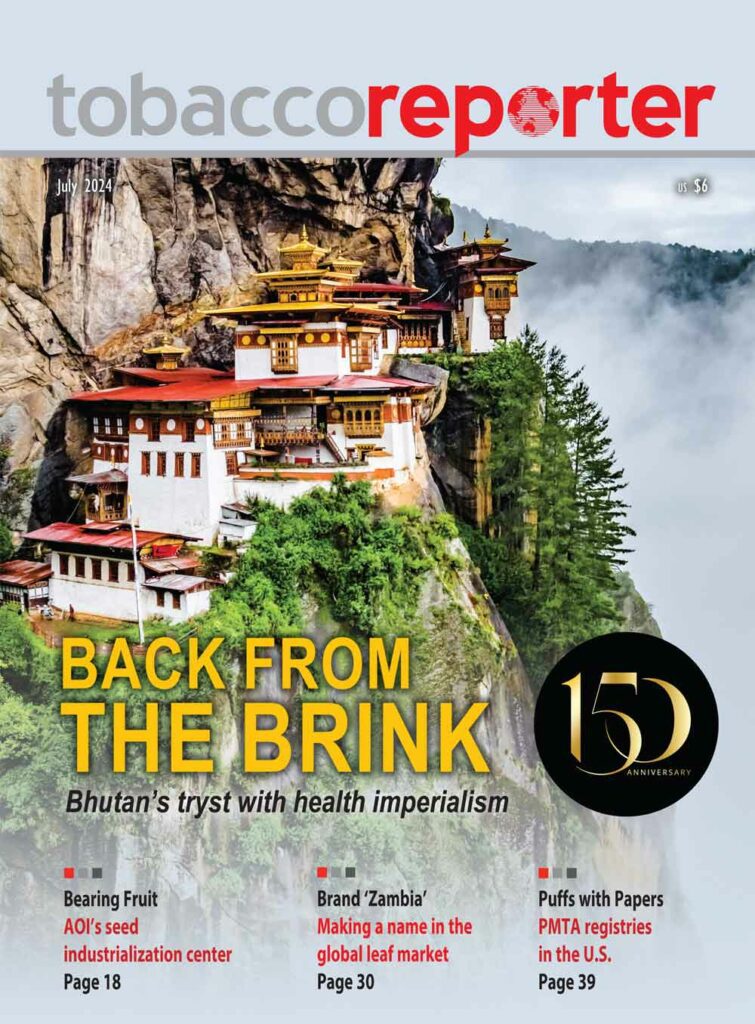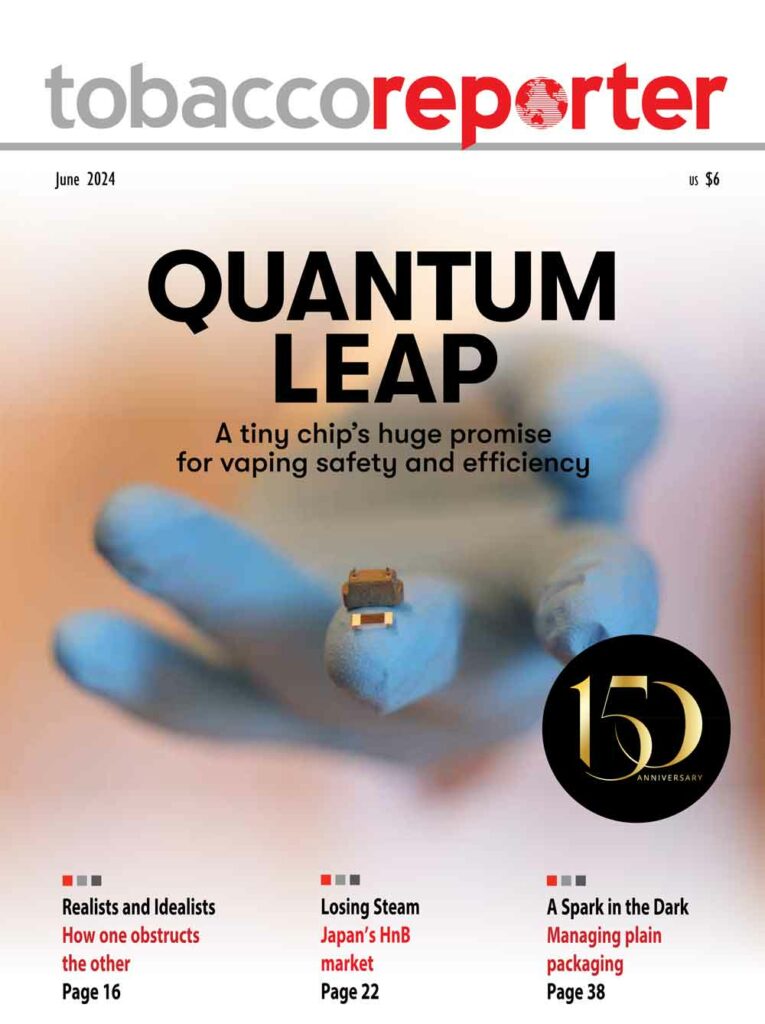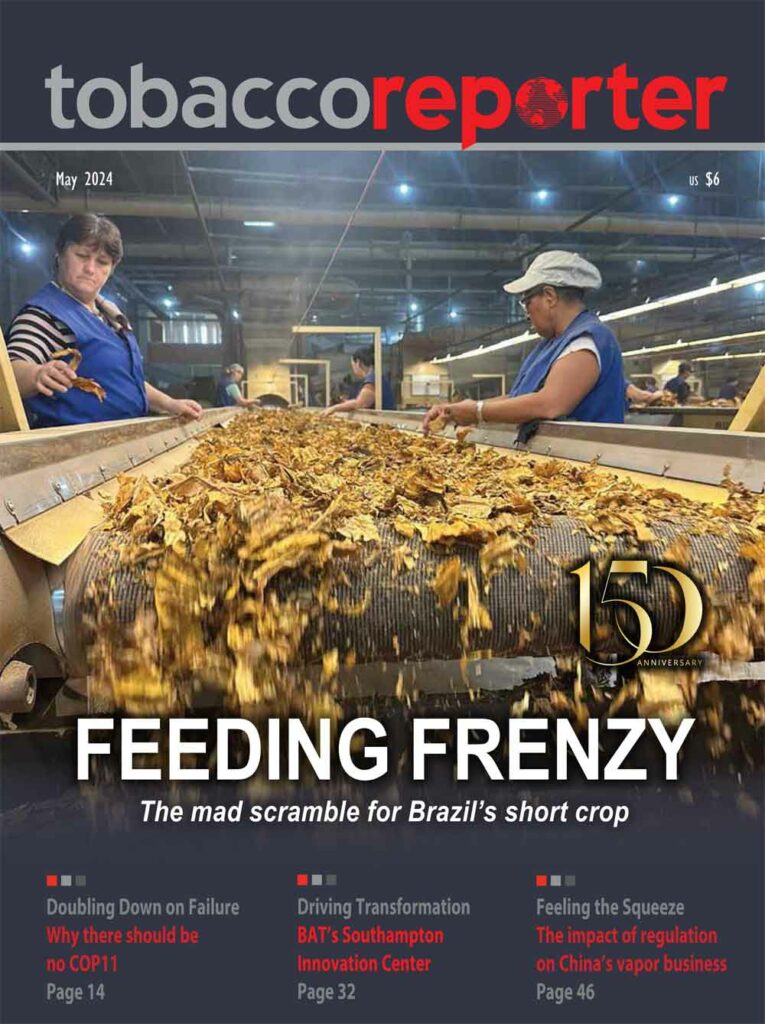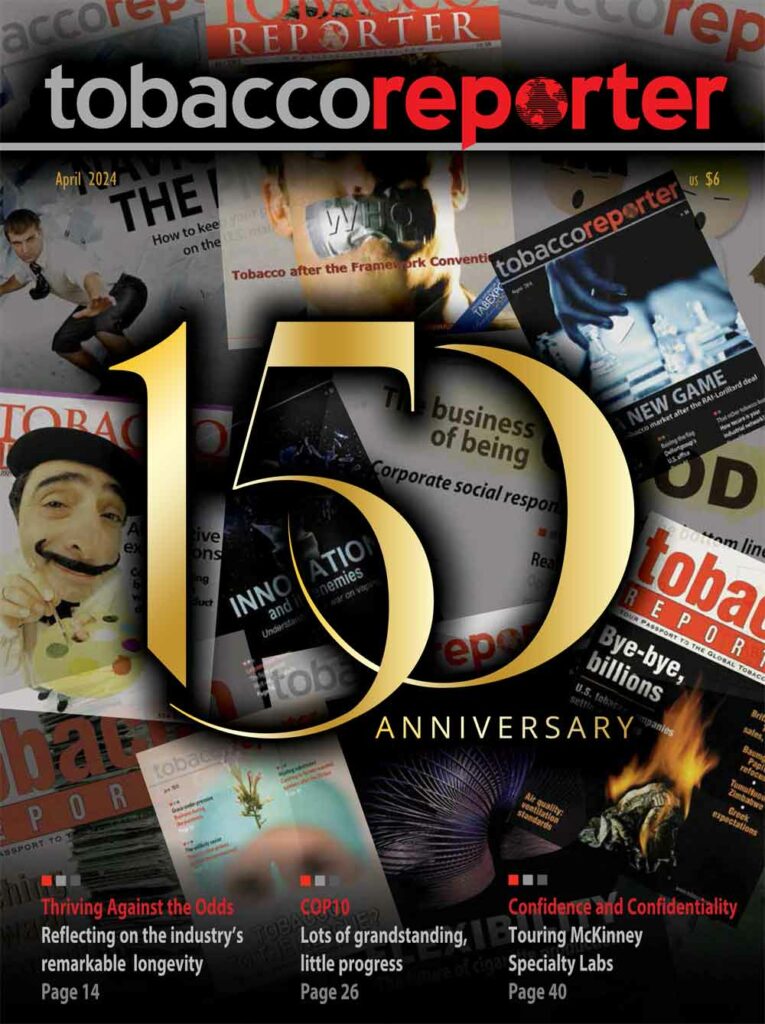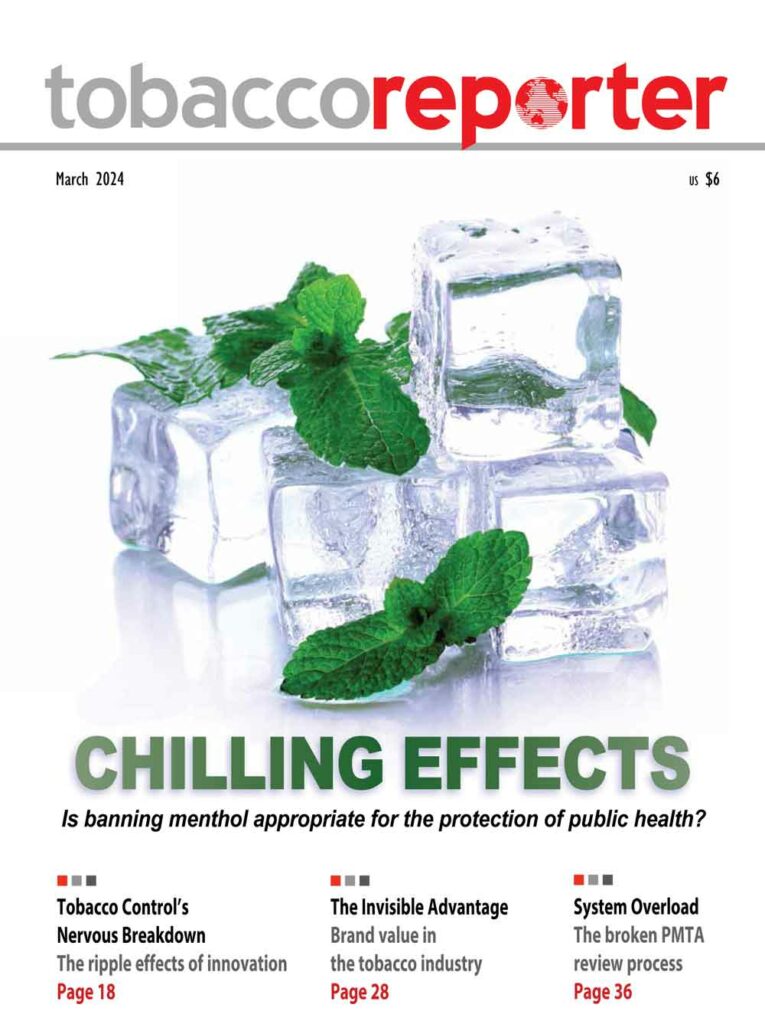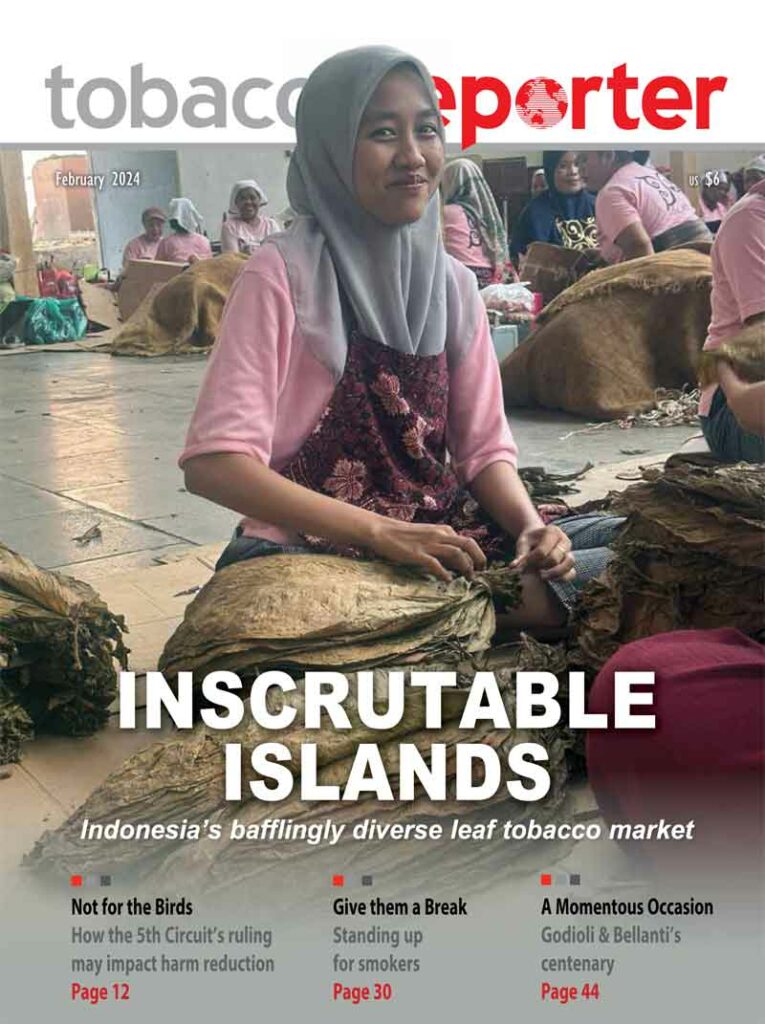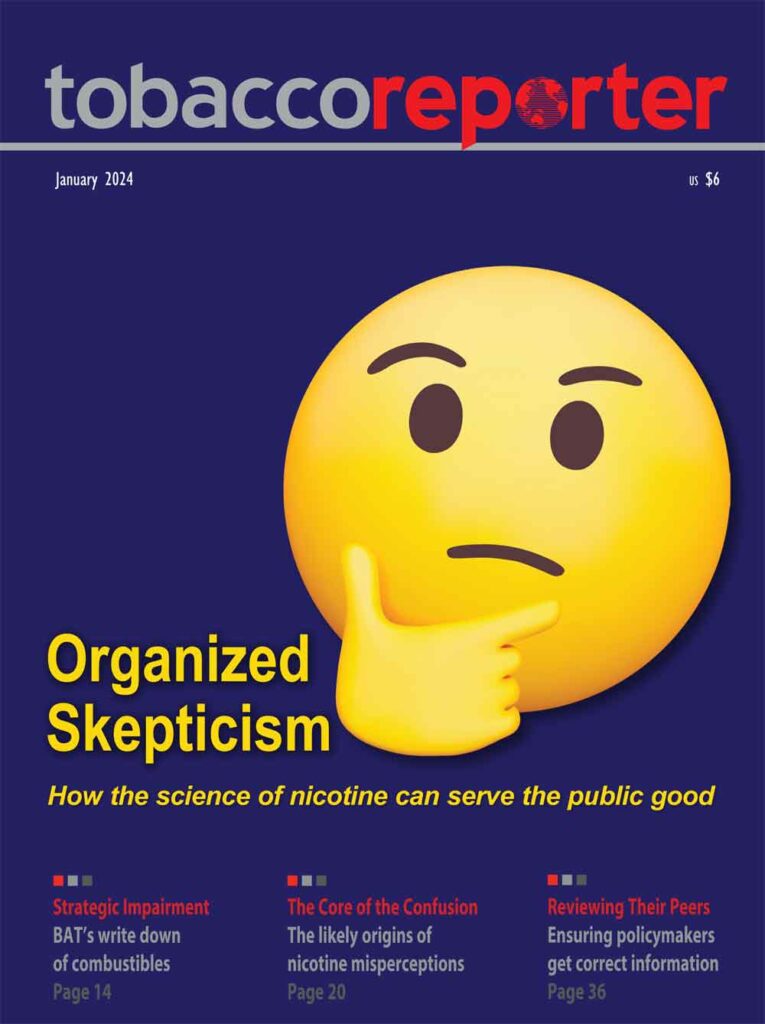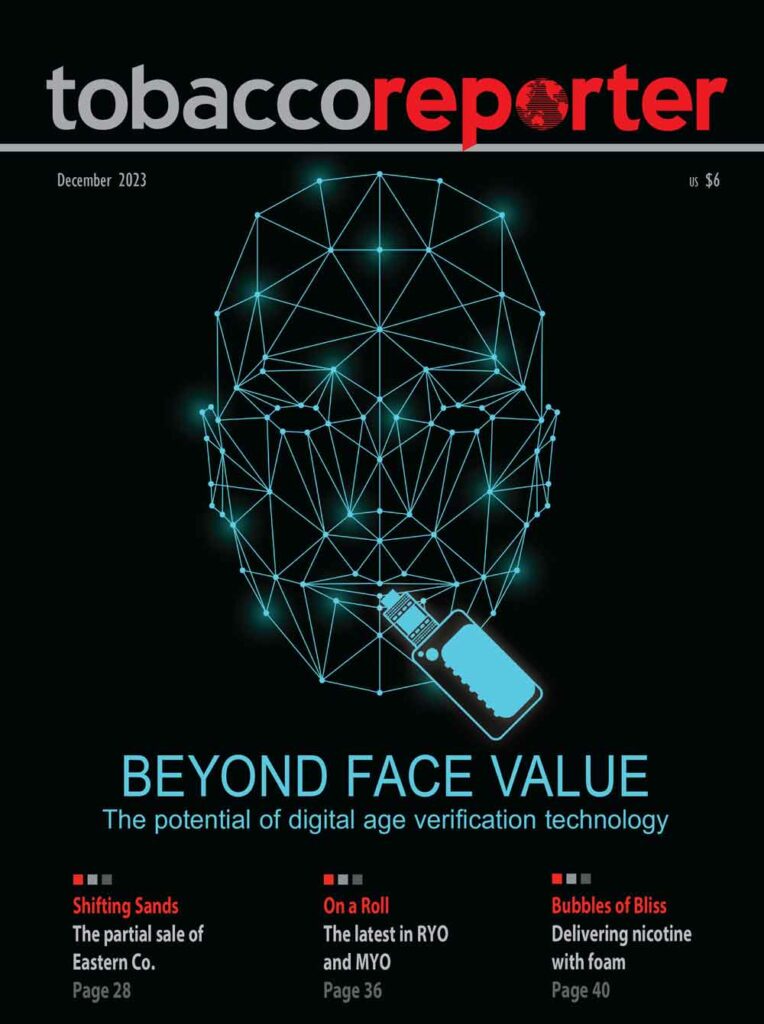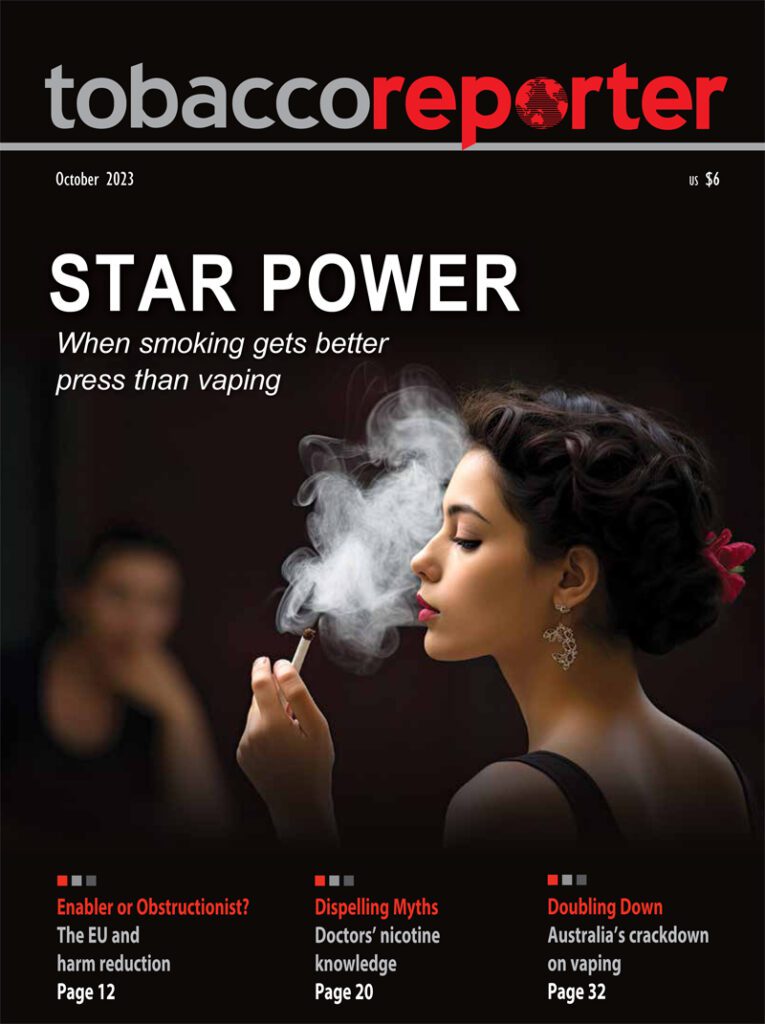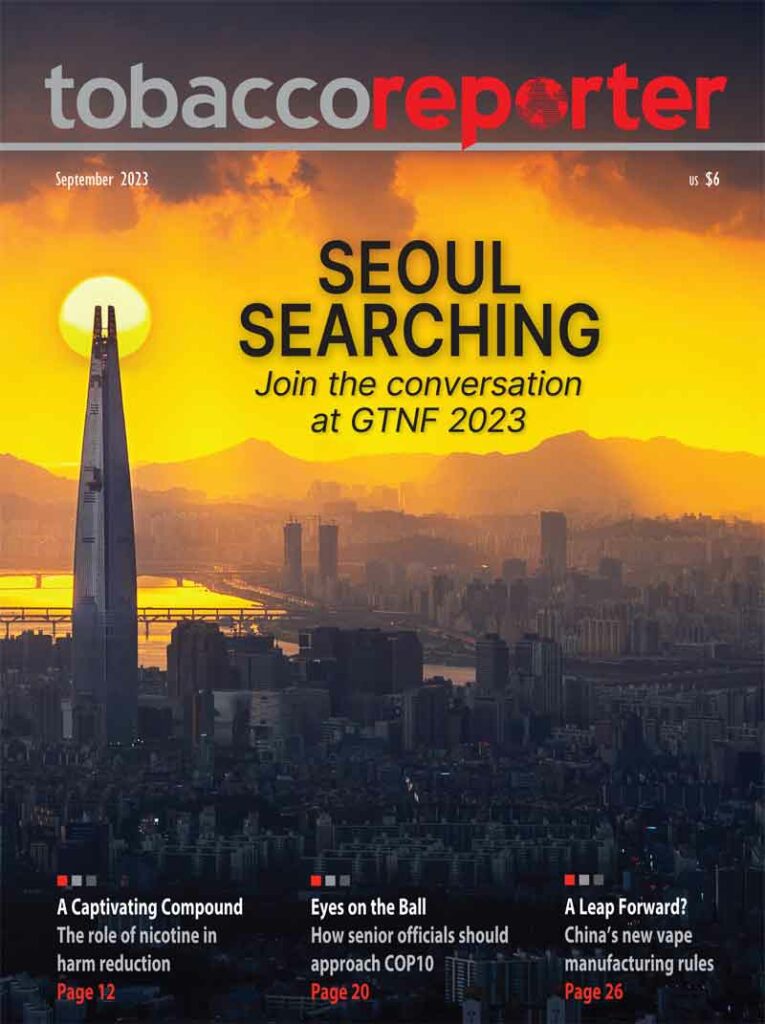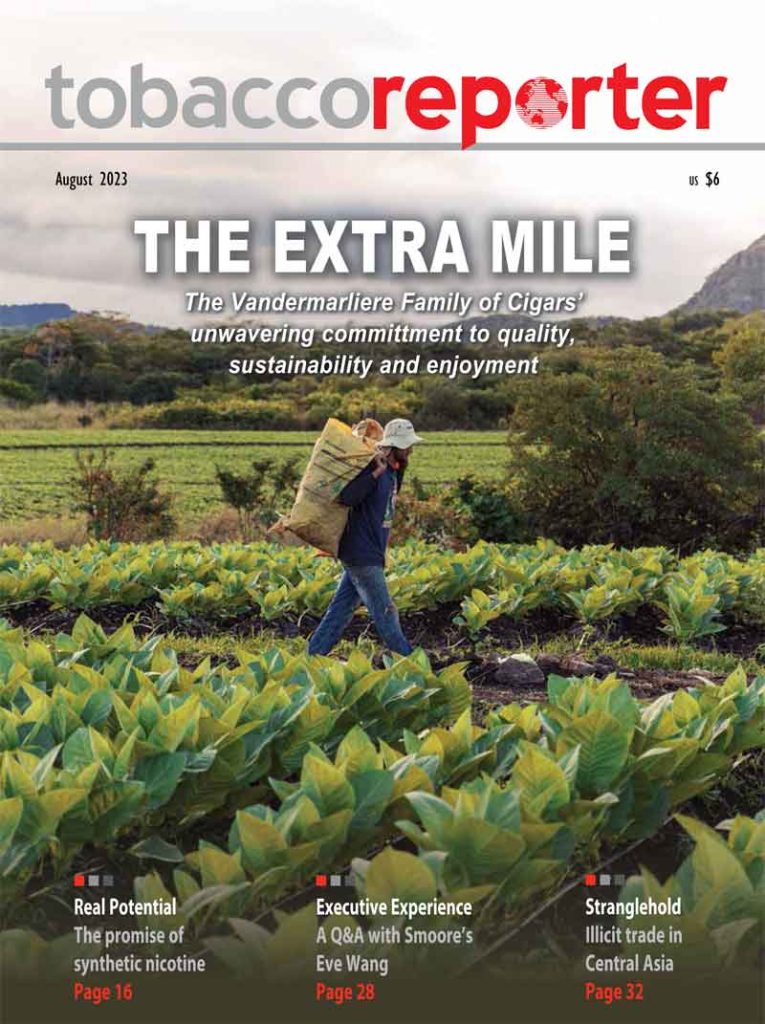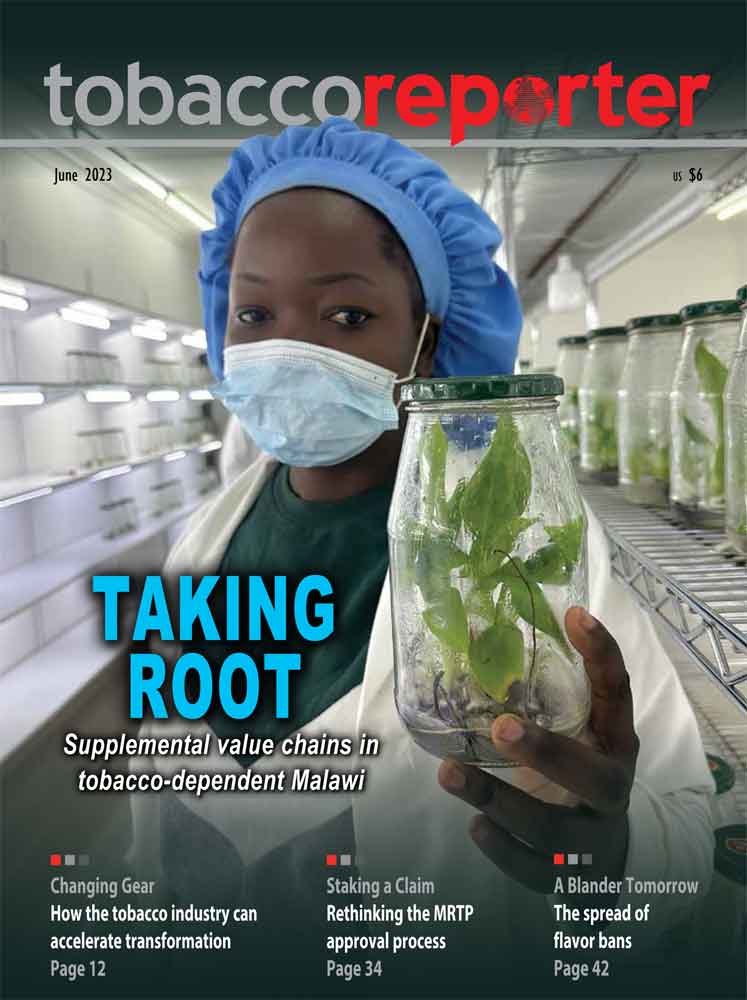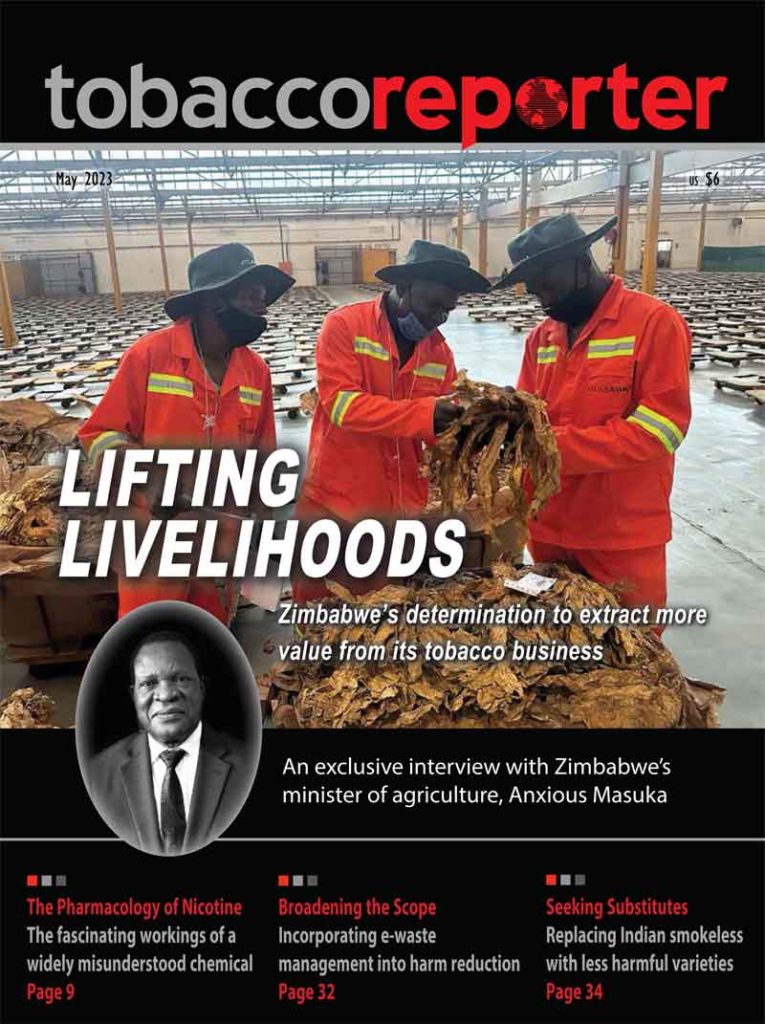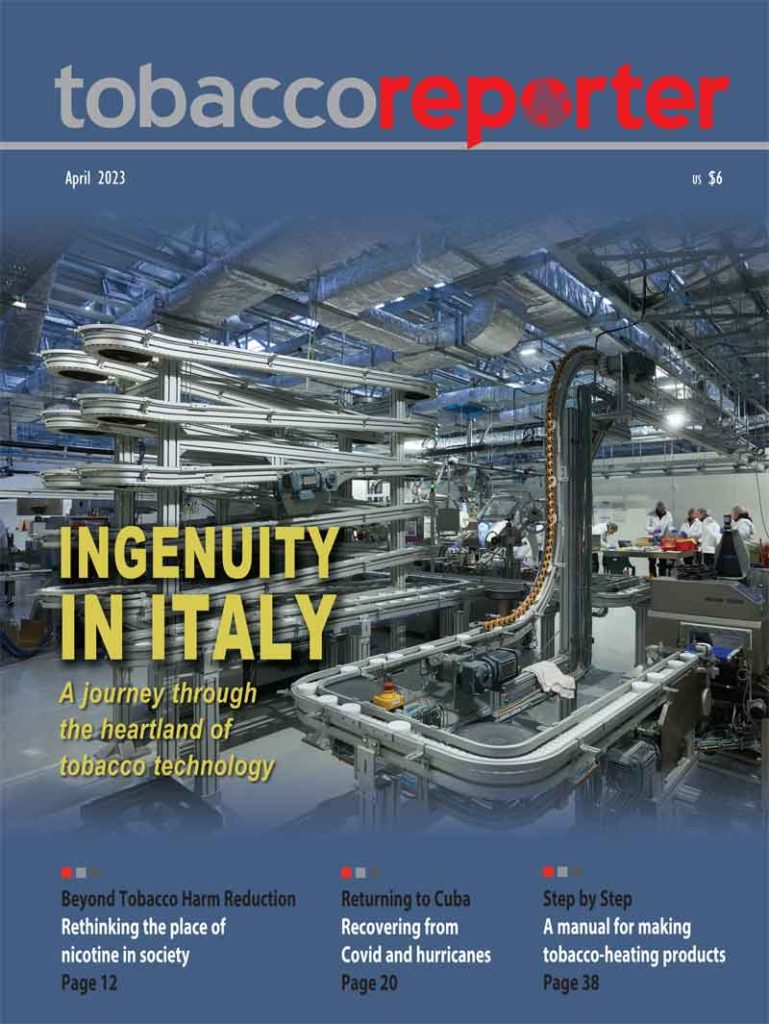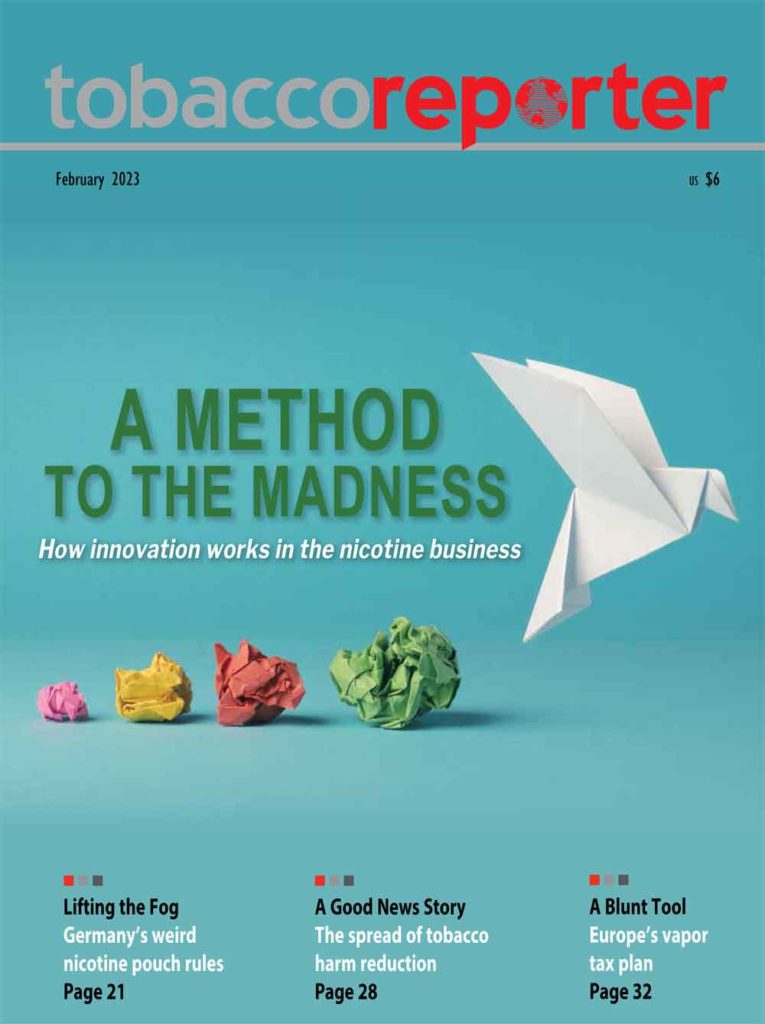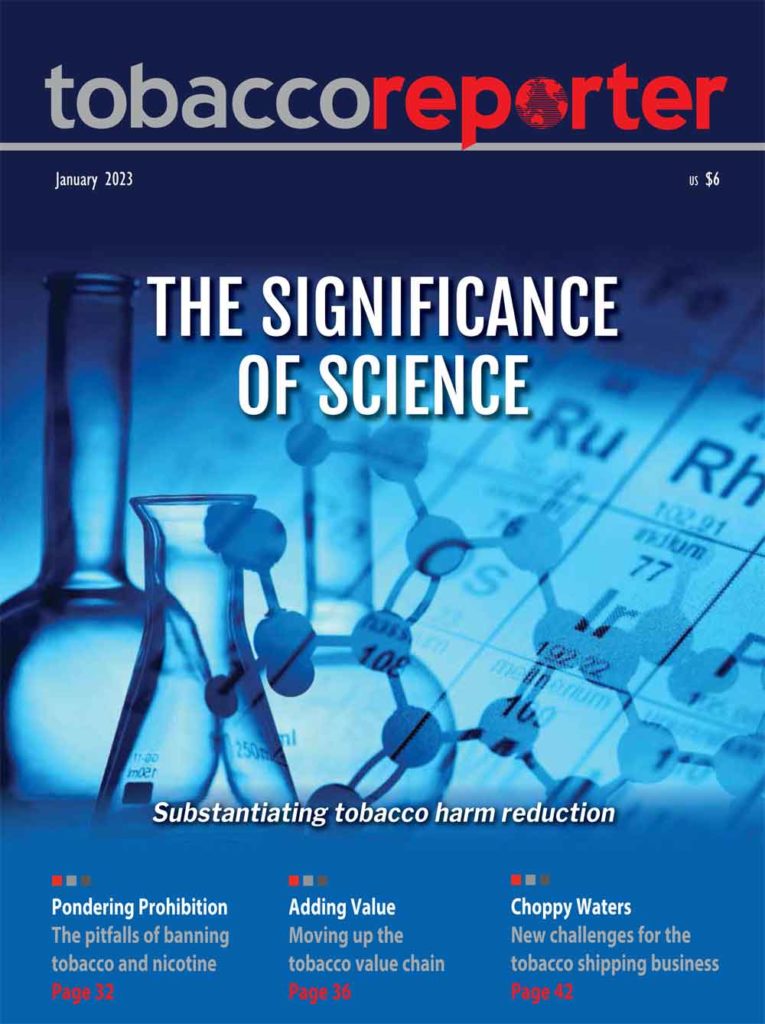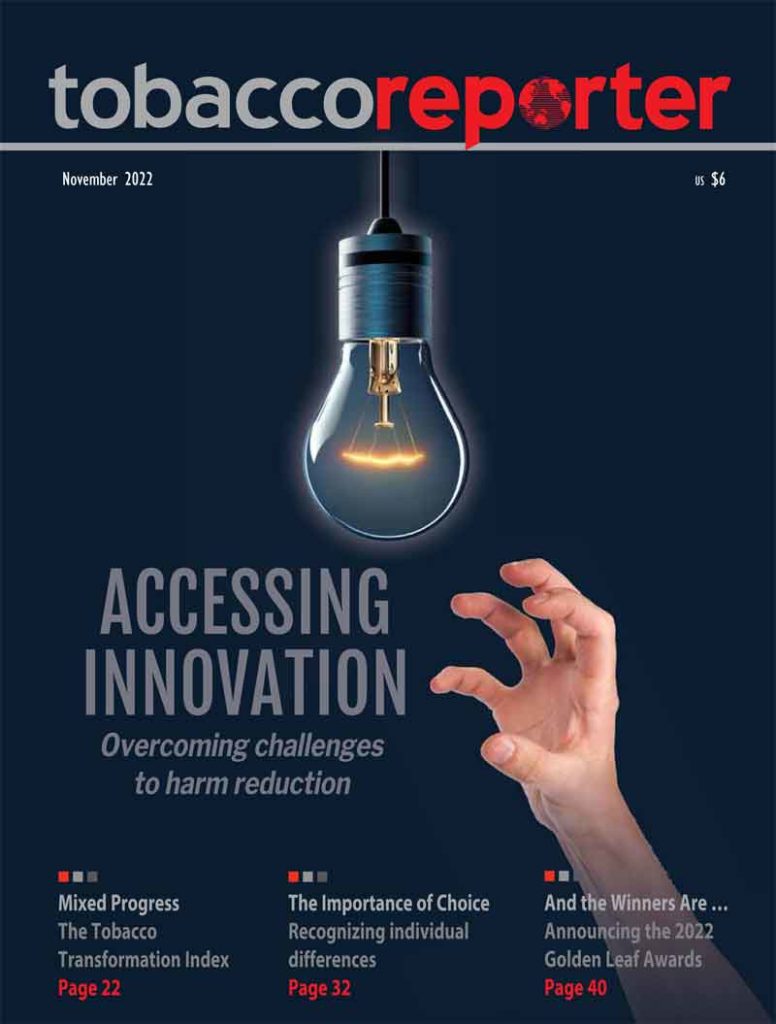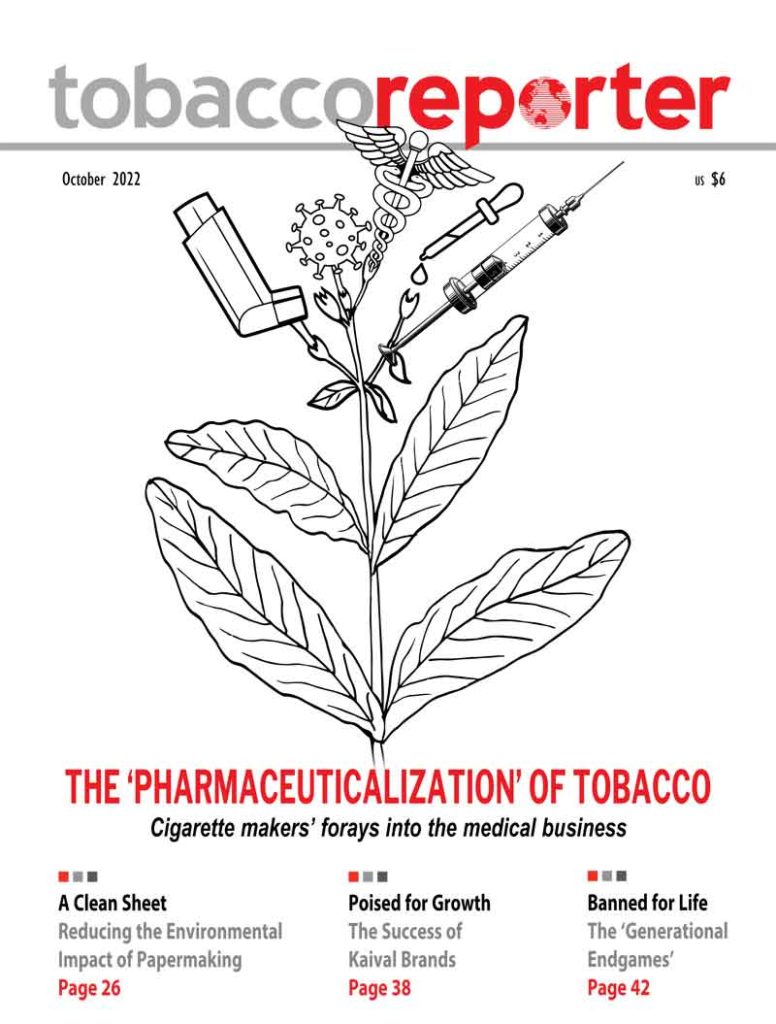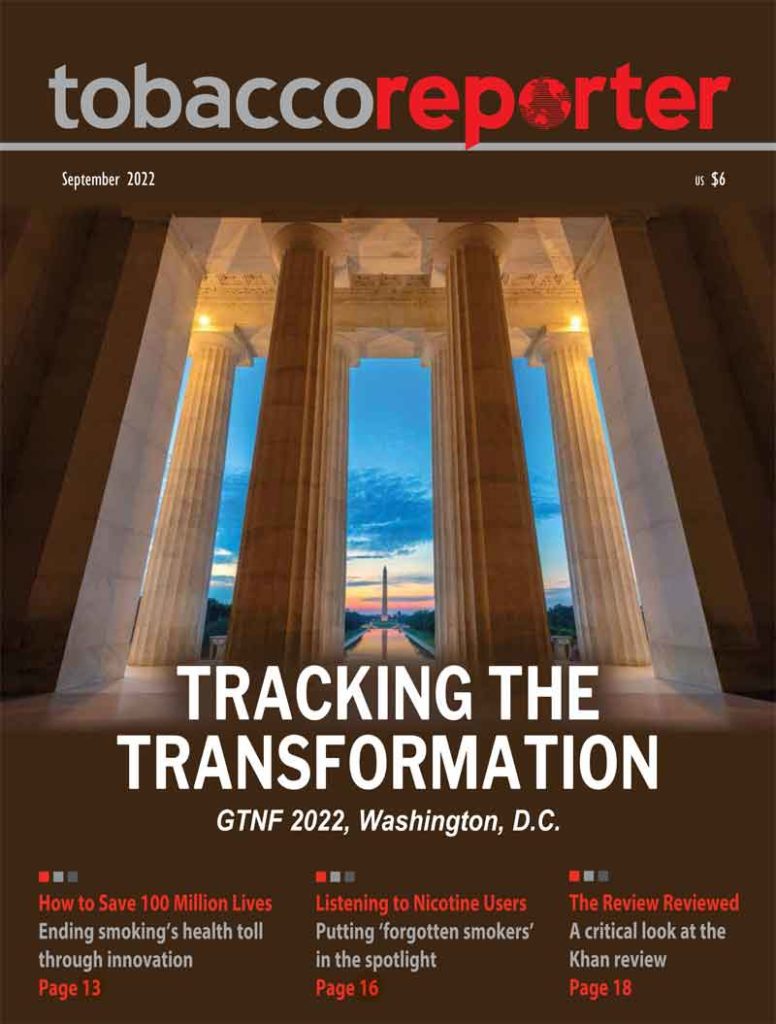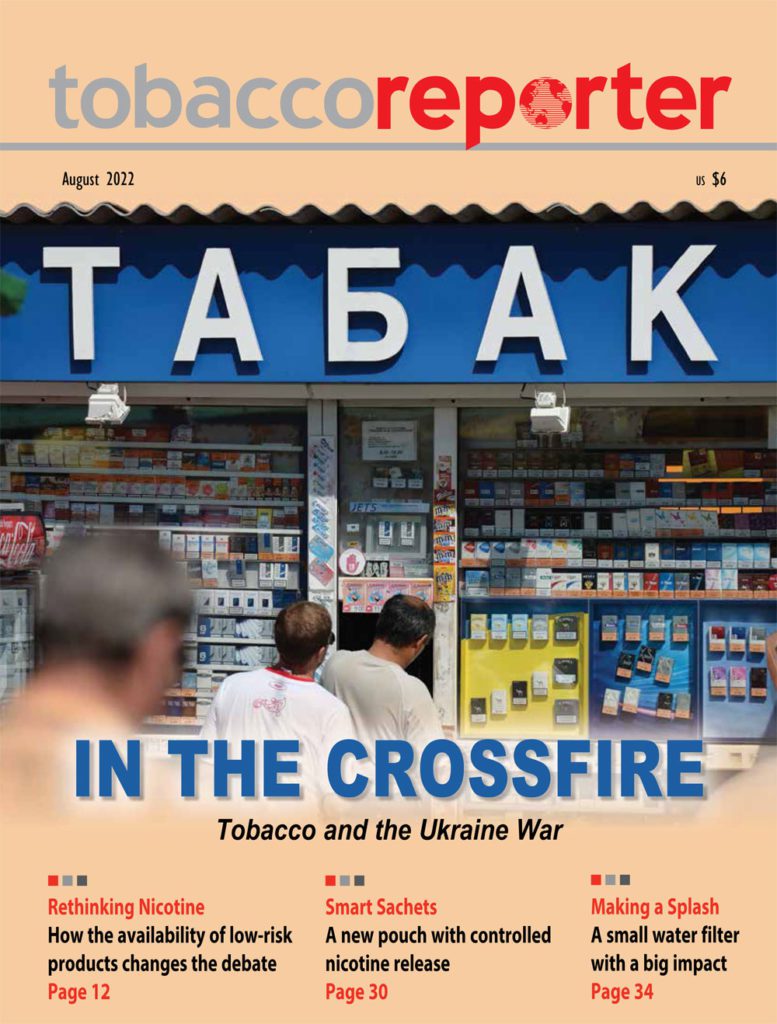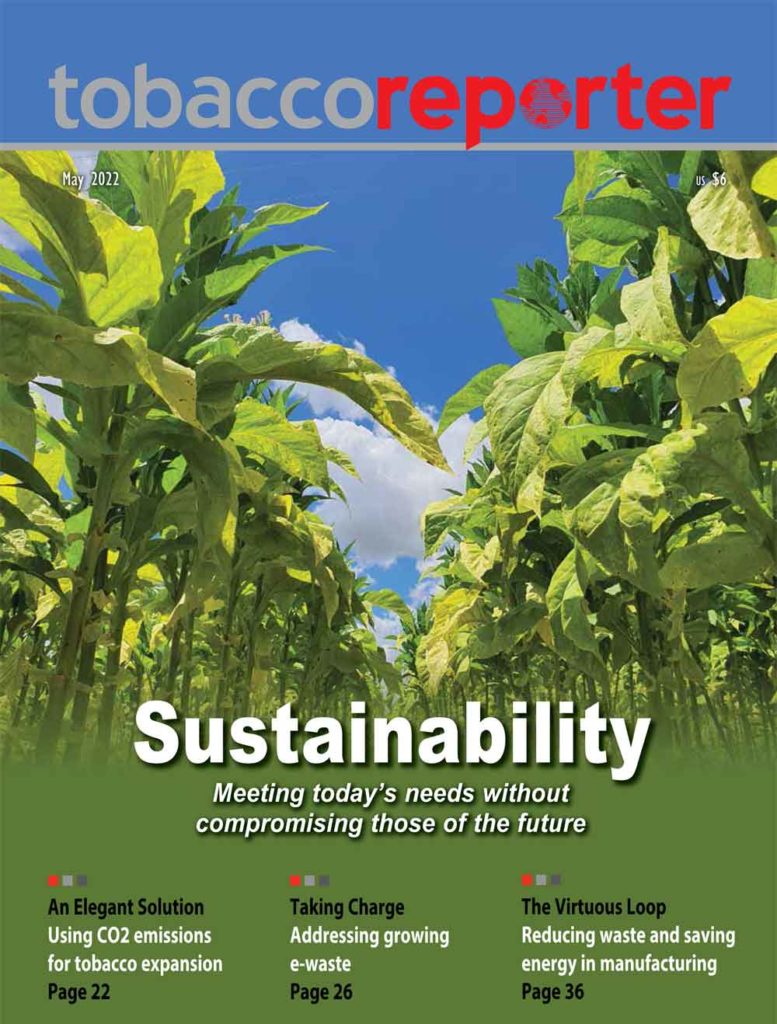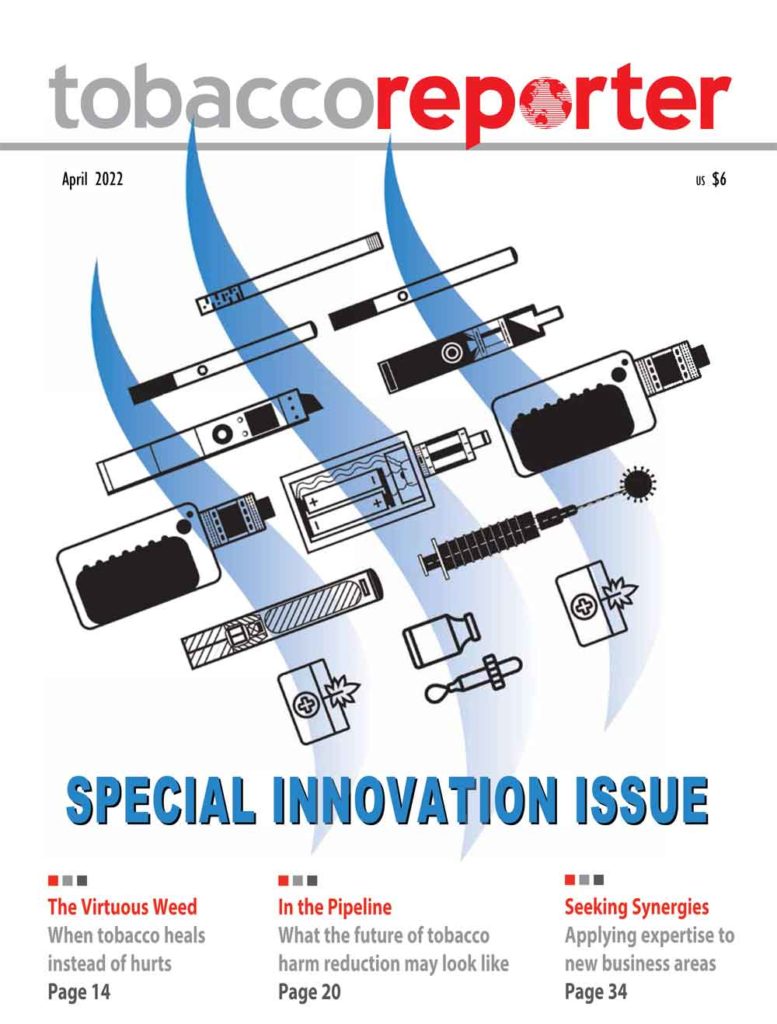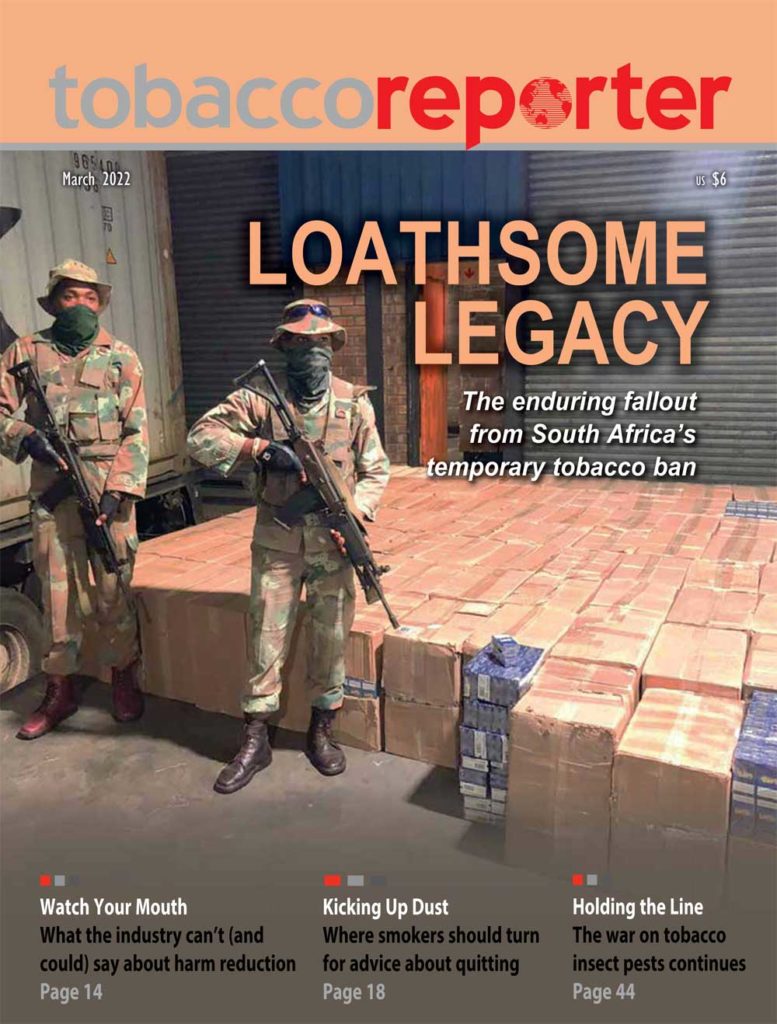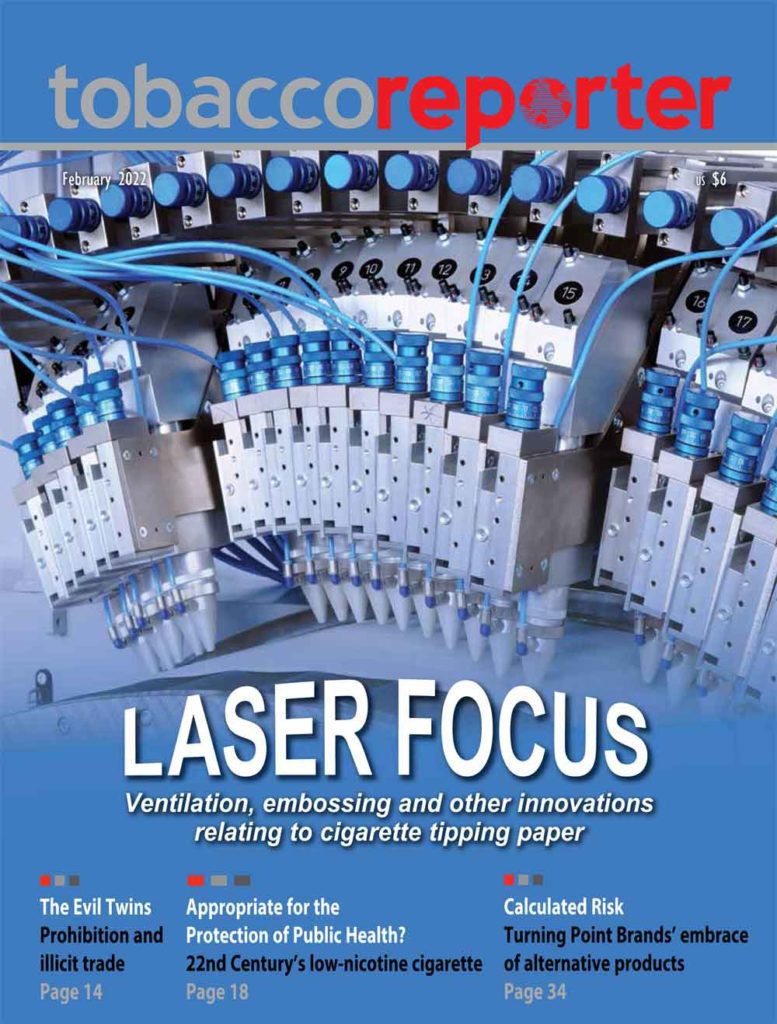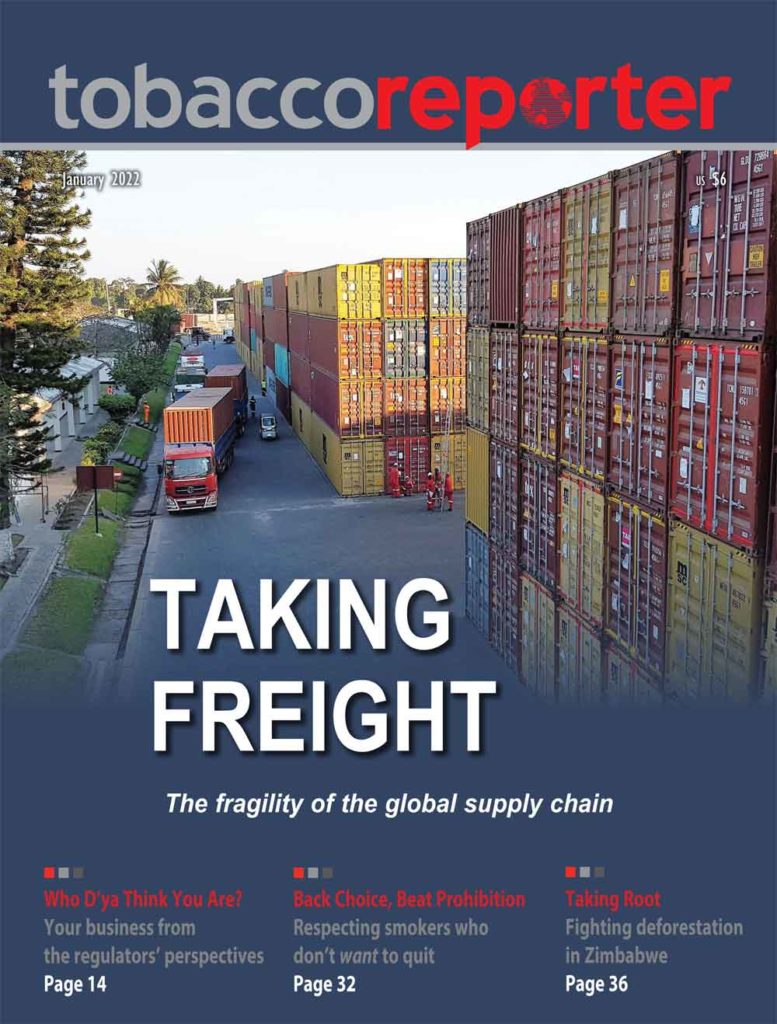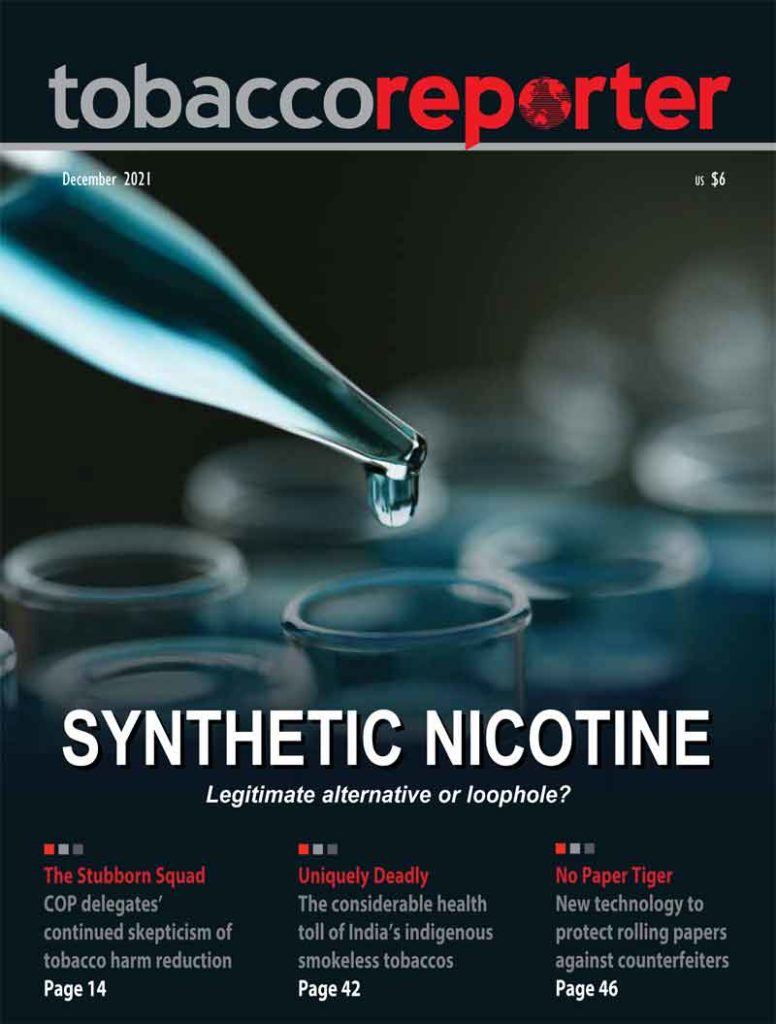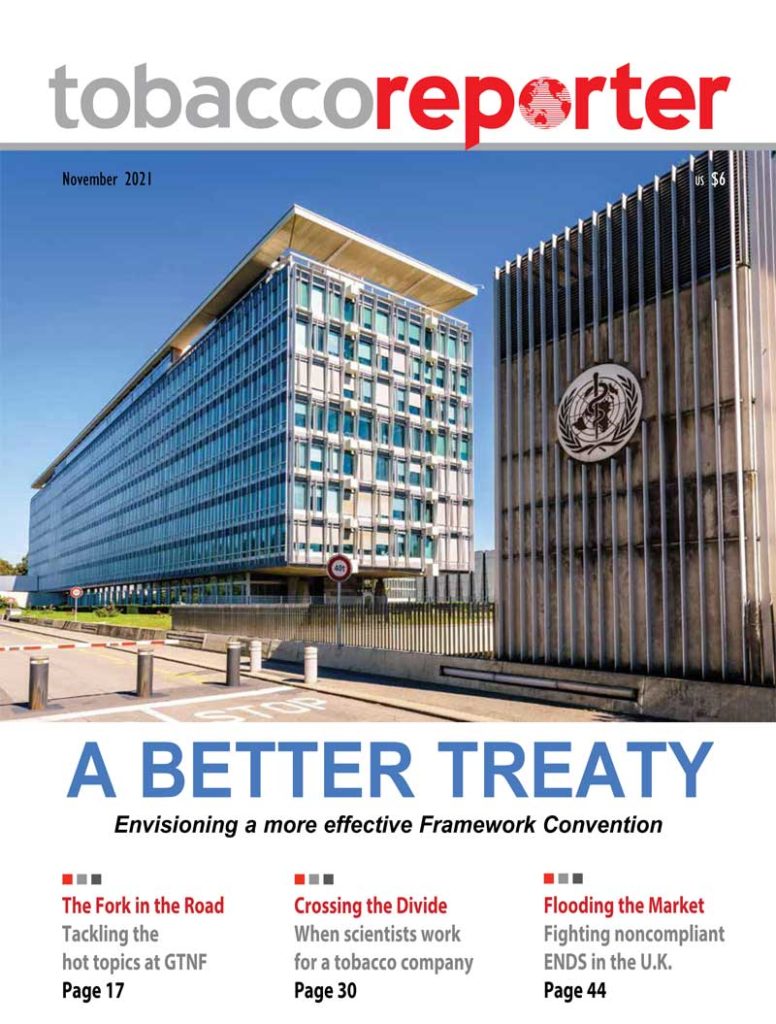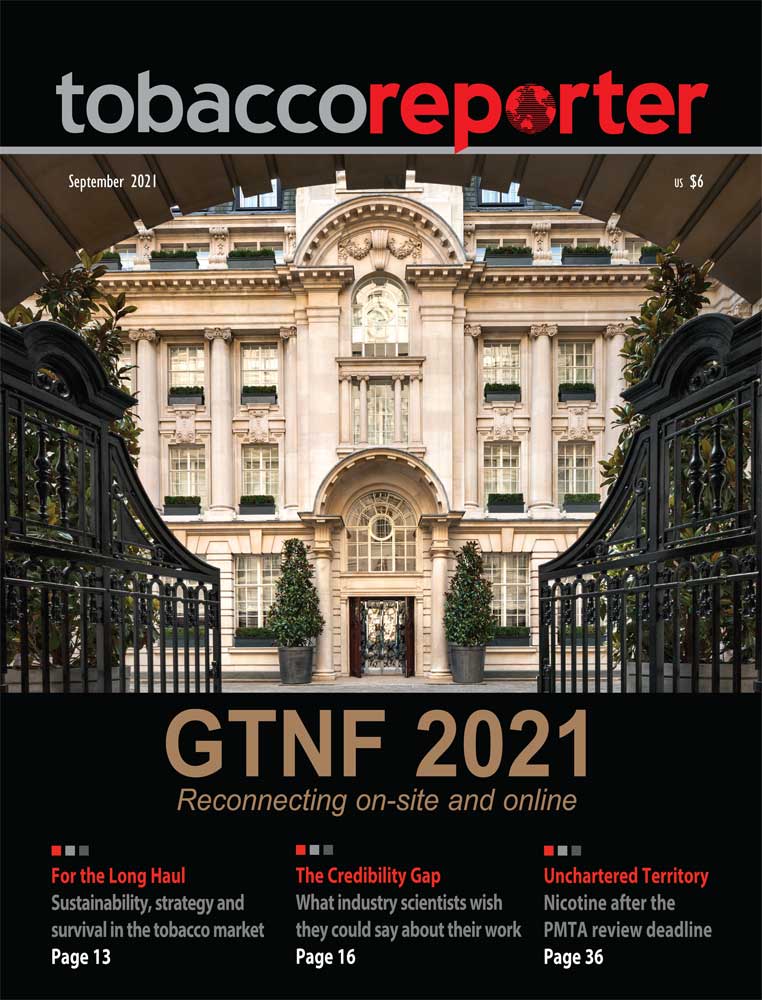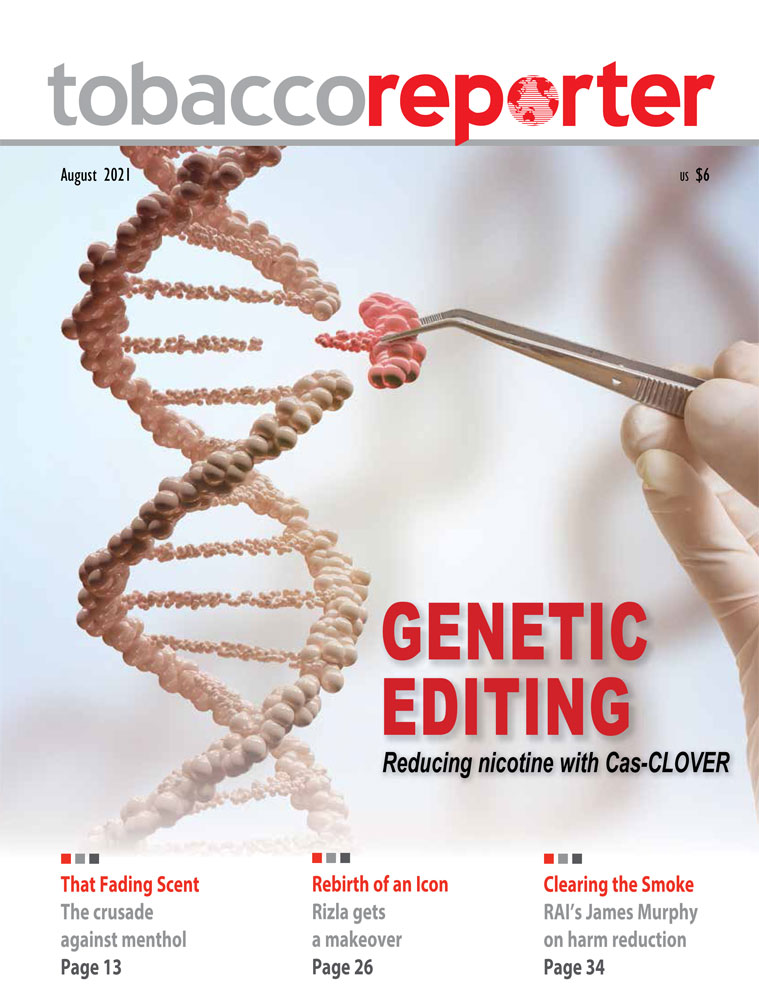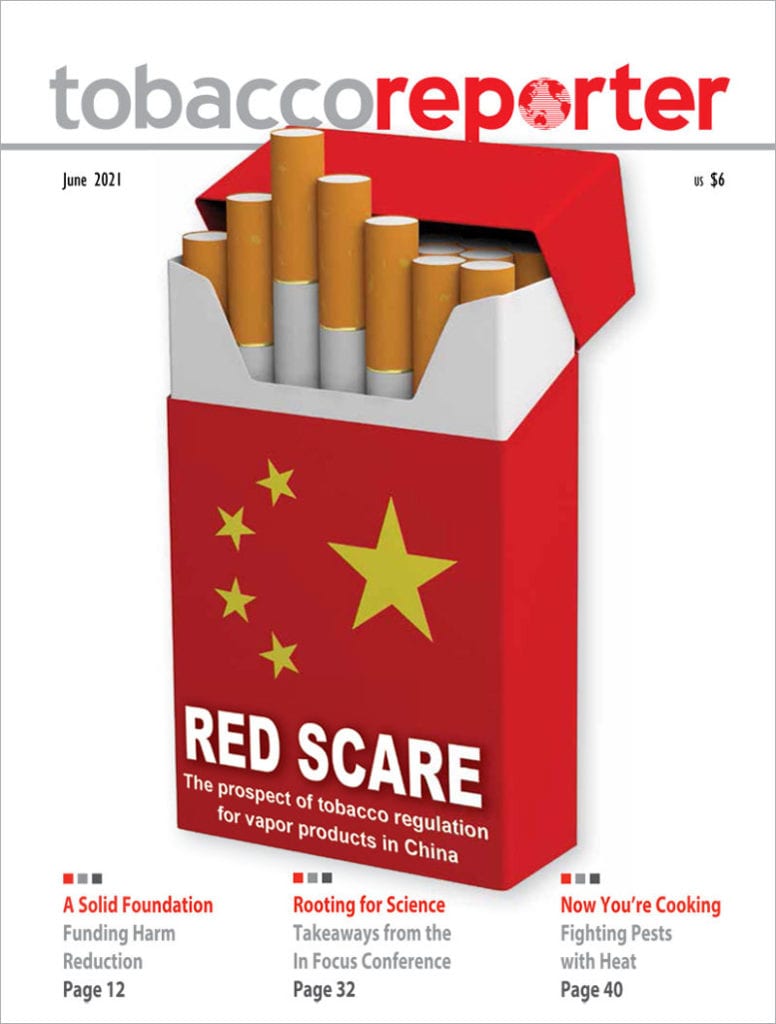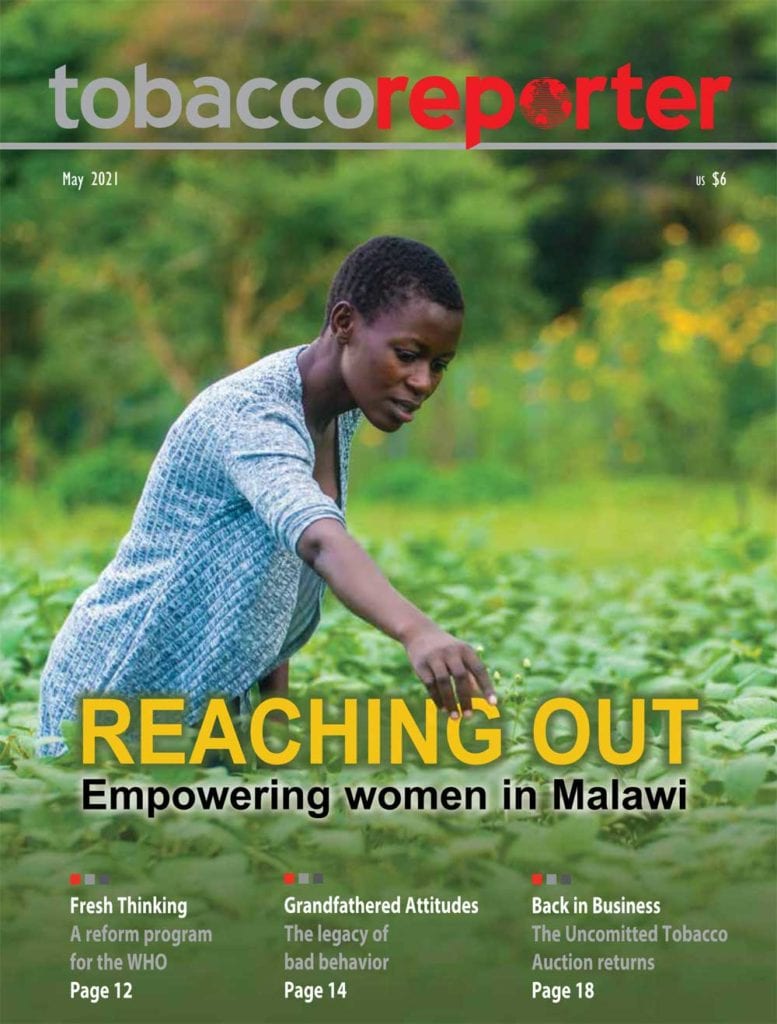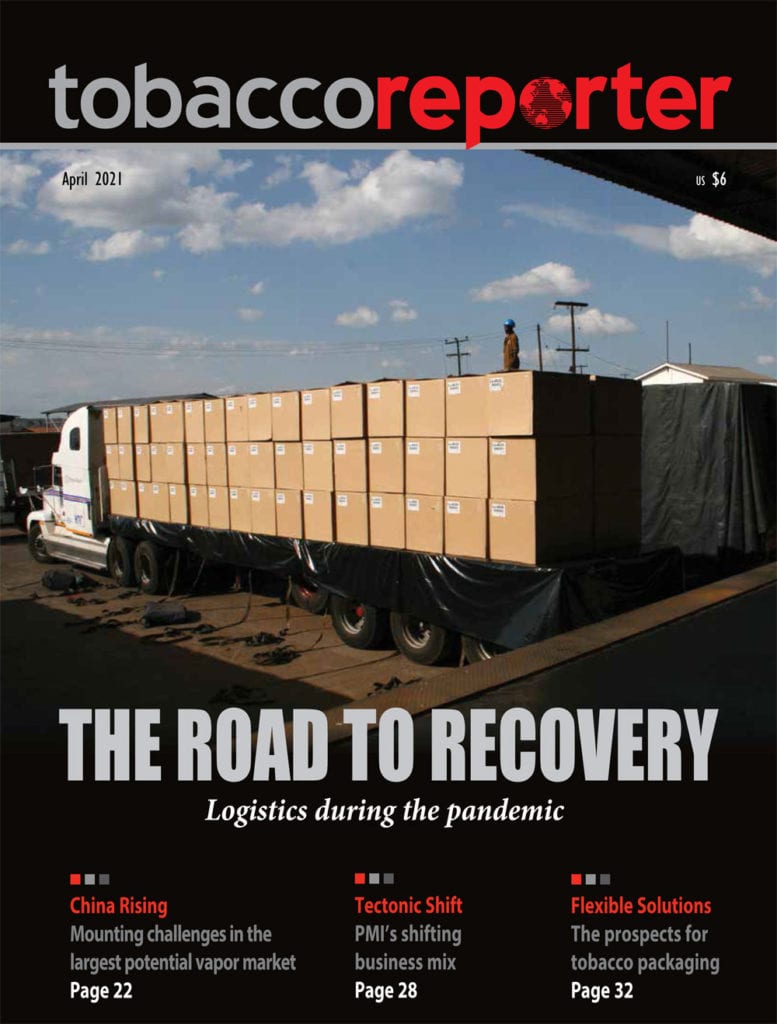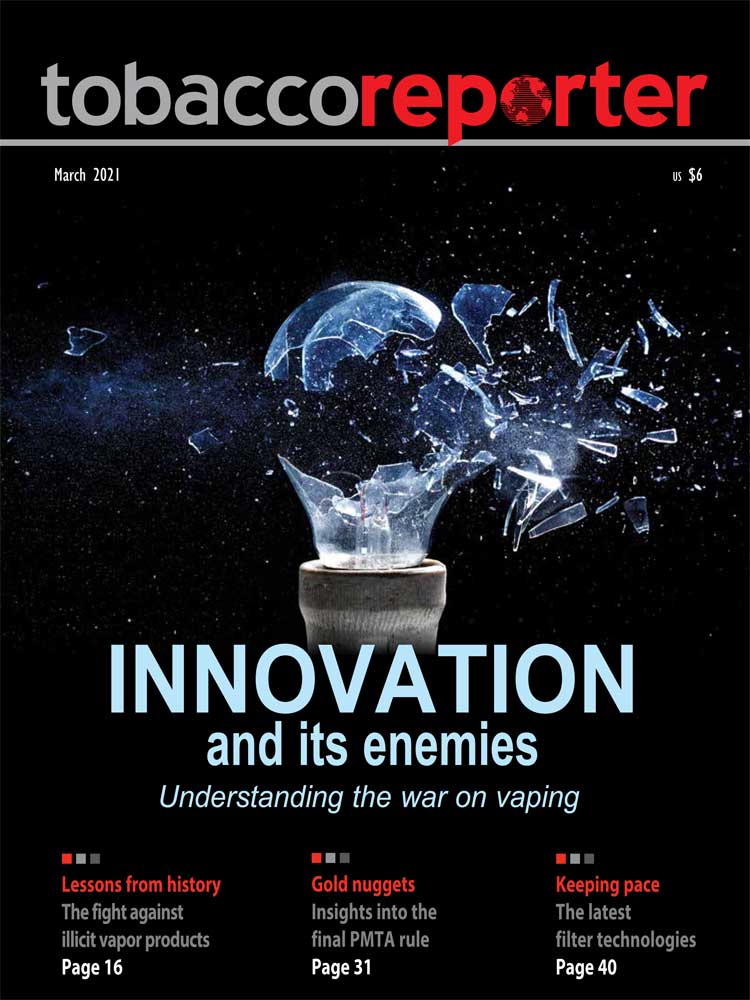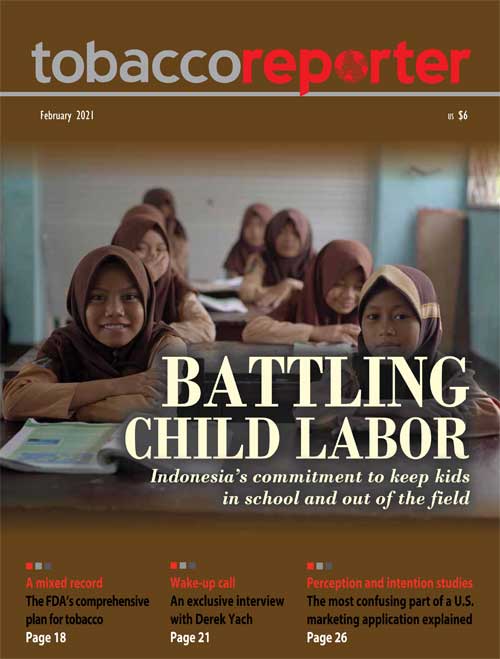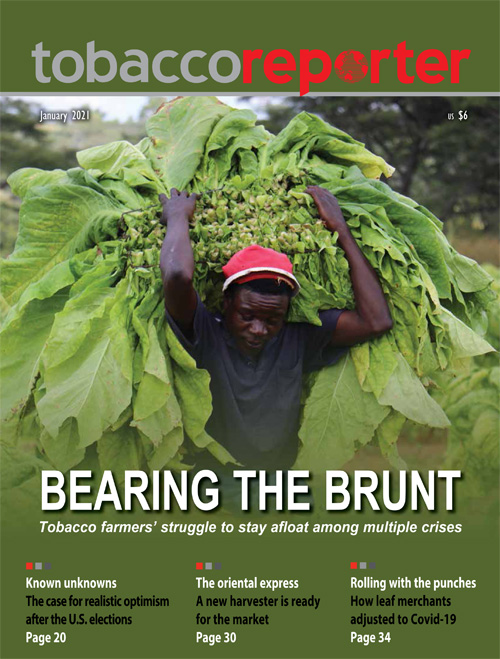For its July 2024 issue, Tobacco Reporter visited Bhutan to investigate that country’s tobacco ban and subsequent U-turn. What factors contributed to the Himalayan kingdom’s change of heart? And what lessons does its experience hold for other nations contemplating tobacco-free generations and “endgames?”
Tim Donahue examines the impact of vape product registry bills in the United States as states try to compensate for meek federal enforcement. George Gay reports from Zambia, which wants to step out of the shadow of its tobacco powerhouse neighbor, Zimbabwe, and make a name for itself on the global leaf market. Stefanie Rossel visited Cerdia’s filter colloquium.
Also in this issue: a report on Alliance One International’s seed industrialization unit in Brazil and a profile of Your Tobacco Link, a new leaf global merchant combining the strengths of JEB International and Tobacco Trading and Services.
Tobacco Reporter’s June 2024 issue highlights a breakthrough with the potential to significantly enhance vaping safety, performance and experience. Whereas most developments over the past years have focused on finetuning the substrates and print materials in ceramic-based systems, Greentank insists its heating chip technology is ‘unlike anything witnessed in the industry before.’
Clive Bates explains why those committed to minimizing the risks of nicotine consumption should celebrate realists and beware of idealists, while Cheryl Olson examines tobacco harm reduction in the Middle East—a region with traditionally high rates of smoking.
Pieter Vorster and Sudhanshu Patwardhan debate whether tobacco harm reduction is reaching The Global South, and Stefanie Rossel reports on a novel nicotine particulate from TJP Labs.
Also in this issue: dispatches from China, Poland and Japan, along with a profile of SPI Developments, where Henri Tuck recently handed the reigns to Danielle Roxborough.
In its May 2024 issue, Tobacco Reporter covers the mad scramble for Brazil’s smaller-than-expected tobacco crop this year. In an in-depth article, Taco Tuinstra analyzes not only the current marketing season, but also the long-term challenges facing Brazil’s tobacco industry, which include acute labor shortages, an aging grower base and increased regulatory focus on farming in the wake of the 10th Conference of the Parties to the Framework Convention on Tobacco Control.
Cheryl Olson examined how people stop smoking in “the real world.” While randomized controlled trials are the widely acknowledged gold standard in research, they fail to capture the often messy quitting experiences of millions.
George Gay visited BAT’s recently inaugurated innovation center in Southampton, U.K., and left encouraged about science’s ability to help improve the lives of consumers.
Samrat Chowdhery explains how India came to deny consumers legal access to safer ways of consuming nicotine, and Stefanie Rossel describes how China’s regulations have impacted the vaping business.
Also in this issue: A report from the recent TMA annual meeting and conference, where CEO Chris Greer announced an exciting rebranding initiative.
This year marks our publication’s 150th anniversary. To celebrate, our April 2024 issue reflects not only on a century and a half of editorial excellence, but also on the remarkable endurance of the nicotine business in an increasingly challenging operating environment. What is the secret of its success?
Unfortunately, there was less to brag about by the parties to the Framework Convention on Tobacco Control, which held their 10th meeting recently. As Stefanie Rossel reports in this issue, the Panama gathering featured lots of grandstanding but marked little progress toward the treaty’s goal of reducing the health impact of smoking.
Cheryl Olson investigated where the industry stands with ESG. Even as the term is falling out of fashion in some quarters, she found that the nicotine business remains firmly committed to the concept.
Timothy Donahue reports from the Habanos cigar festival in Cuba and Catharine Dockery shared with us the business strategy of her Vice Ventures fund, which specializes in good companies in supposedly bad industries.
Also in this issue: A profile of McKinney Specialty Labs in Richmond.
Among the many challenges facing the nicotine business today is a potential ban on menthol cigarettes in the United States, where minty flavored smokes account for about a third of the market. In the March issue, Cheryl Olson asks whether banning menthol is appropriate for the protection of public health and highlights some of the potential unintended consequences.
Professor Ming Deng contemplates the future of vaping as more jurisdictions crack down on disposable e-cigarettes, and concludes that this is an opportune time for the industry to revisit the fundamental purpose of vaping—harm reduction and providing a superior consumer experience.
Clive Bates explains how innovation in the recreational nicotine market is revolutionizing not only the tobacco industry but also disrupting tobacco control. ITG Brands’ Steven McDonald analyzes the broken PMTA review process, and Stefanie Rossel examines how the Houthis’ attacks on commercial vessels are impacting the movement of tobacco products through one of the world’s busiest shipping lanes.
Also in this issue: an analysis of brand value in the tobacco industry. Among the many changes over the years, one thing has remained remarkably consistent: intangible assets continue to be a major contributor to the real value generated by the nicotine business.
For our February 2024 issue, Tobacco Reporter traveled to Indonesia, where it encountered a leaf market unlike any other. Whereas most origins specialize in one of two internationally recognized tobaccos, Indonesia produces a baffling array of varieties, many of them unique to the island nation.
So diverse are the products on offer that one aspiring leaf trader was advised to forget about his experiences in Zimbabwe and Brazil and instead draw inspiration from the Hogwarts School of Witchcraft and Wizardry, the fictional magical boarding school in J.K. Rowling’s Harry Potter series.
Cheryl Olson examines the impact of the recent ruling by the U.S. Court of Appeals for the 5th Circuit on the Food and Drug Administration’s approach to premarket tobacco product applications, which asserts that nicotine product manufacturers have been treated unfairly. What will the verdict mean for tobacco harm reduction?
George Gay explores why smokers face a greater degree of ostracization than those engaging in other risky activities and Stefanie Rossel reports on the thriving markets for herbal heated products and nicotine pouches.
Also in this issue: Godioli & Bellanti’s 100th anniversary.
In Tobacco Reporter’s January 2024 issue, Clive Bates asks how the science of tobacco and nicotine can serve the public good. Skepticism, he argues, underpins the scientific process, and uncertainty is a pervasive, permanent and evolving feature of scientific understanding.
Stefanie Rossel profiles the Center of Excellence for the Acceleration of Harm Reduction, which evaluates nicotine-related science to help ensure that policymakers and the public receive accurate and reliable information.
Jessica Zdinak highlights a recent study on the impact of flavored e-cigarettes on adult smokers, and Sudhansu Patwardhan traces the origins of the prevailing misperceptions about nicotine.
Cheryl K. Olson explores the role of religious convictions in smoking cessation, and Brand Finance Managing Director Richard Haight analyzes BAT’s remarkable decision to write down the value of some of its U.S. cigarette brands.
Also in this issue: a discussion among plant breeders and crop science experts about the challenges of developing low-nicotine tobacco.
Tobacco Reporter’s December 2023 issue examines the potential of digital age verification technology to help deter underage access to nicotine products. Facial recognition systems have come a long way in a recent years, but also raise privacy concerns.
The technology that conveniently unlocks your smartphone can also be used by autocrats to monitor their subjects, marketers to tracks your behavior and thieves to steal your identity. In his article “Beyond Face Value,” George Gay weighs the pros and cons based on a U.K. experiment.
Cheryl Olson explores the challenges and opportunities for tobacco harm reduction for people with mental health needs, who tend to smoke at higher rates than the overall population. Stefanie Rossel delves into the Egyptian government’s recent selloff of a stake in its tobacco monopoly, and Taco Tuinstra reports on the nicotine flavoring business in the Spice Islands (Indonesia).
Also in this issue: A new technology that delivers nicotine through foam.
In its November 2023 issue, Tobacco Reporter looks back at one of the most successful editions of the Global Tobacco and Nicotine Forum yet. Held in September, the event in Seoul featured world-class speakers from various walks of life, including public health advocates, regulators and even prominent lawmakers. Due to space limitations, our print edition GTNF coverage is supplemented by additional reporting online.
Stefanie Rossel examines various tobacco-heating technologies. As it turns out, there are multiple roads leading to Rome. Cheryl K. Olsen highlights several triumphs in tobacco harm reduction that are likely to surprise skeptics.
George Gay scrutinized the U.K. plans for a generational tobacco ban and concludes that this will work only if properly implemented—that is, if less harmful tools of nicotine consumption remain available to those prevented from smoking.
Taco Tuinstra visited Smoore’s new facility in Indonesia—the company’s first outside of China—and was impressed by its unrivaled level of sophistication and automation.
Also in this issue: a profile of Collaboration Traditab Santele, which is successfully marketing European tobacco products based on their geographic origins.
In its October 2023 issue, Tobacco Reporter tackles the widespread misunderstandings of relative risk.
As Cheryl Olson observes in her cover story “Star Power,” smoking has lately been getting more favorable press coverage than vaping, despite the fact that the former is significantly riskier than the latter.
But it’s not just excitable headline writers who are getting it backward. As it prepares to update its Tobacco Product Directive, the European Commission appears inclined to regulate all nicotine products as if they were combustible cigarettes, according to Clive Bates.
The misconceptions extend even to those whose job is to know better. In his article “Dispelling Myths,” George Gay marvels at the findings of a recent study among physicians, in which nearly 80 percent of respondents erroneously identified nicotine as the main culprit in smoking-related disease.
Such misconceptions, along with negative press coverage, are discouraging doctors from steering smokers who won’t quit toward less harmful nicotine products—an outcome that is especially detrimental in Australia, where nicotine vapes are available only on prescription (see “Doubling Down,” by Stefanie Rossel).
In other coverage, we examine efforts to help tobacco farmers diversify their incomes and initiatives by several industry suppliers to reduce the environmental impact of its business.
Also in this issue: The latest developments in reconstituted tobacco
In its September 2023 issue, Tobacco Reporter looks ahead at the Global Tobacco & Nicotine Forum (GTNF) and the 10th Conference of the Parties (COP10) to the Framework Convention on Tobacco Control, which are scheduled to take place this northern-hemisphere fall.
Both gatherings seek to reduce the health problems associated with tobacco consumption, but they will be advocating markedly different solutions. While the delegates at COP10 will be touting product bans, tax hikes and legal action, participants in the GTNF are likely to emphasize the opportunities presented by new technologies to help smokers transition to less-harmful products.
Grant Churchill of Oxford University explains why nicotine is not the culprit in tobacco-related disease, and Clive Bates, a former U.K. senior civil servant, offers COP10 delegates suggestions to make the most of their participation.
Cheryl Olson explores the question of how to communicate tobacco products’ relative risks more effectively, and Ian Fearon of McKinney Regulatory Science Advisors examines the potential impact of China’s new rules on vape manufacturing.
Further in this issue: an analyses of the acetate tow market, which has been suffering from shortages, and a critical look at the U.S. Food and Drug Administration’s plans to set nicotine limits and ban menthol as a tobacco flavor.
We also reveal the winners of the Golden Leaf Awards.
In Tobacco Reporter’s August 2023, Derek Yach examines the promise of synthetic nicotine. Not only does synthetic nicotine improve the toxicological safety profile of delivery devices, but it also helps reduce carbon emissions, water use and deforestation associated with tobacco growing.
Cheryl Olson tackles some of the major tobacco-related misconceptions that are preventing harm reduction efforts from living up to their full potential. The 2019 EVALI crisis, for example, continues to be associated with nicotine vaping in the minds of many long after it was proven to be caused by illicit THC products. The myth that youth vaping is a gateway to smoking, too, persists despite evidence to the contrary.
Stefanie Rossel profiles the Vandermarliere Family of Cigars, which has been diligently expanding its sales and distribution networks worldwide, while doubling down on its commitment to quality and enjoyment.
George Gay examines the roll-your-own and make-your-own markets, two traditional niches that have spawned a remarkable amount of innovation.
Also in this issue: An exclusive interview with Eve Wang, vice president of Smoore, the world’s largest atomization company.
In Tobacco Reporter’s July 2023 issue, Sudhansu Patwardhan explores how the rise of synthetic nicotine could contribute to food security by reducing demand for leaf and releasing land currently dedicated to tobacco cultivation to other crops.
At the same time, Patwardhan laments the World Health Organization’s attempts to pit tobacco growers against a hungry world. As the International Tobacco Growers Association (ITGA) has pointed out in response to the WHO campaign, the percentage of arable land dedicated to the golden leaf worldwide is relatively small, and many tobacco farmers grow food crops, too.
Derek Yach urges medicinal licensing of e-cigarettes and nicotine pouches to advance tobacco harm reduction, and Cheryl Olson explains why tobacco companies won’t “just stop” selling cigarettes, as critics urge. While it is possible to switch off the machines, doing so would not end demand, according to Dave Dobbins, former chief operating officer of the Legacy Foundation/Truth Initiative. The ensuing vacuum would be quickly filled by illegal suppliers unrestrained by product standards,
Jessica Zdinak of Applied Research and Analysis Co. stresses the importance of understanding consumers to help move them down the risk continuum, and Stefanie Rossel interviewed ITGA’s Ivan Genov about global supply and demand for leaf tobacco.
Also in this issue: A profile of newcomer Atlas Agri, which is working to increase Zimbabwean tobacco volumes by reducing post-harvest losses.
For Tobacco Reporter’s May 2023 issue, Taco Tuinstra visited Malawi to learn how that nation is trying to reduce its heavy reliance on tobacco. Deriving between 40 percent and 70 percent of its export earnings from the golden leaf, Malawi is the world’s most tobacco-dependent country. In a good year, the crop brings relative wealth to the country’s tobacco-growing communities and much-needed foreign currency to help the nation import products and services it cannot produce domestically. In a bad season, there is poverty in the villages.
Supported by leaf tobacco merchants and the Foundation for a Smoke-Free World, Malawi has started developing new supplemental value chains and breathing life into ones that had fallen to the wayside. Many of the projects are still in their infancy, but stakeholders are hopeful that over time they will help make Malawi’s economy more resilient as global demand for tobacco levels off.
Clive Bates examines how the tobacco industry can accelerate its transformation toward less-harmful products and Cheryl Olsen calls for a rethink of the U.S. modified-risk tobacco product approval process. Barnaby Page reflects on the global spread of flavor bans and Stefanie Rossel highlights initiatives to reduce the environmental impact of disposable vapes.
Also in this issue: A photographic impression of the recent TabExpo trade fair in Bologna.
In an exclusive interview, Minister of Agriculture Anxious Masuka explains how the country will boost the crop to 300 million kg and create a $5 billion tobacco business by 2025. Tobacco Reporter also spoke with various stakeholders, including the trade and the scientific community, on the challenges and opportunities associated with such an ambitious undertaking. Will Zimbabwe be able to sell 300 million kg as global cigarette consumption stagnates? And will it be able to achieve the desired volumes in line with customers’ ESG expectations?
In a three-way discussion, Sudhanshu Patwardhan, John Dunne and Pieter Vorster discuss another environmental concern—that of growing e-waste. To properly address this challenge, the panelists urge stakeholders to expand the definition of tobacco harm reduction to include product lifecycle management.
Grant Churchill of Oxford University describes the pharmacology of nicotine, a widely misunderstood chemical; Tobacco Reporter’s George Gay profiles a bold new venture by a leaf tobacco veteran in the Democratic Republic of the Congo; and our colleague Stefanie Rossel explores efforts to replace India’s “uniquely deadly” variety of smokeless tobaccos with less harmful alternatives.
Also in this issue: An overview of the roll-your-own tobacco market, which under the proper fiscal conditions, can serve as a buffer against illicit cigarettes.
The Covid-19 pandemic changed how the world operates, including how people communicate and interact. Tobacco Reporter’s April 2023 issue marks the return of the magazine’s writers traveling and interacting with sources face-to-face. Timothy Donahue traveled to Cuba to learn about the latest developments in that country’s legendary cigar industry.
In anticipation of TABEXPO, Stefanie Rossel traveled through northern Italy, which has traditionally been home to many tobacco-related businesses and continues to attract new tobacco investments, such as Philip Morris International’s state-of-the-art heated-tobacco factory and BAT’s innovation hub.
Clive Bates urges stakeholders to rethink the role of nicotine in society while Cheryl Olson explores what it would take for women to switch to smokeless products.
Marissa Dean digs into Brazil’s leaf market and what’s expected following last year’s record earnings, and George Gay reviews SWM’s step-by-step manual for producing tobacco heating products.
Also in this issue: a reflection on the productive life of Tobacco Reporter’s former owner, Dayton Matlick, who passed away in February.
Youth smoking in the United States is at a record low, according to the 2022 National Youth Tobacco Survey. Instead of celebrating, however, many anti-tobacco activists are wringing their hands about the relative increase in vaping. Are campaigners reluctant to credit e-cigarettes for choking off youth smoking? Cheryl Olson investigates.
Vladislav Vorotnikov examines the persistent illicit cigarette trade in the Balkans, which he traces back to the bloody breakup of Yugoslavia, when the various antagonists needed money to fund their war efforts. Even today, political and business elites throughout the region remain connected to cigarette smuggling, according to Vorotnikov.
Stefanie Rossel reports on Greenbutts’ environmentally friendly cigarette filter, which according to the manufacturer disperses in water within several minutes with agitation and begins to degrade in compost within several days.
George Gay analyzes the predicament of tobacco freight forwarders as the EU considers whether to tax unmanufactured tobacco, and Marissa Dean explains how changes to the U.S. Tobacco Tax and Trade Bureau reports have made that organization’s data less useful.
Also in this issue: The remarkable return of Filtrona, which after operating under the Essentra umbrella for a decade is now back as an independent company.
Tobacco Reporter’s February 2023 issue explores innovation in the tobacco and nicotine industries. In his book How Innovation Works, author and past GTNF speaker Matt Ridley notes that innovation is not an individual phenomenon but a collective and messy network phenomenon. As Clive Bates explains in this issue, that observation holds very much true for innovation in nicotine business, as well.
Cheryl Olson and Willie McKinney ponder what lessons the U.S. experience with nicotine might hold as regulators contemplate how to regulate cannabis.
Patrick Basham of the Democracy Institute investigated the state of tobacco harm reduction and found something that may surprise readers: Despite noisy resistance in some quarters, the concept is more widely accepted than is often assumed.
Stefanie Rossel examines the outlook for nicotine pouches in Germany (which bizarrely regulates modern oral products as food) following the confirmation by a prominent research institute that pouches are safer than cigarettes.
George Gay urges the European Commission to embrace fresh thinking in its approach to tobacco control and Timothy Donahue interviewed Kim Hesse about the testing of electronic nicotine delivery systems.
Also in this issue: A profile of Godioli & Bellanti, which has been in business for 100 years.
Science has been instrumental in helping reduce the negative health impact of tobacco consumption, not only by enabling the development of product that deliver nicotine without the disease-causing byproducts of combustion but also by allowing researchers to measure the effectiveness of next-generation products.
Unfortunately, not all research is up to snuff. As Clive Bates explains in this issue, many studies suffer from poor methodology, poor interpretation of results and poor extrapolation from findings to policy. Dispiritingly, regulators too appear at times to be motivated by unscientific considerations, as Cheryl Olson observes in her article “Science-Based Regulation?”
Perhaps surprising to some, the best tobacco research these days is probably generated by the industry, which is incentivized by the need to satisfy skeptical regulators about the safety and effectiveness of its next-generation products.
How seriously the industry takes its commitment to science is demonstrated in this issue by David O’Reilly. In an exclusive interview, BAT’s director of scientific research reveals how science is helping the company achieve its vision of “A better tomorrow.”
Also in this issue, we discuss the pitfalls of prohibition, attempts by leaf sourcing countries to move up the tobacco value chain and the challenges facing the tobacco logistics business.
Tobacco Reporter’s December 2022 issue explores the outlook for flavors, both in vaping products and traditional cigarettes. How will the proliferation of flavor bans impact consumption, the industry and ultimately public health? In three separate articles, Clive Bates, Cheryl Olson and Stefanie Rossel examine the issue from different angles.
George Gay looks at the new challenges and opportunities facing Altria Group in the wake of its new partnership with Japan Tobacco International. Stefanie spoke with leading cigarette manufacturers about their efforts to cultivate startups with technologies that may aid the industry’s transition beyond tobacco and nicotine.
Timothy Donahue provides a peek behind the curtain at Smoore, the company behind many of the products that survived the U.S. Food and Drug Administration’s brutal vetting process. And Ivan Genov reports from the International Tobacco Growers’ annual general meeting in Portugal.
Also in this issue: An exclusive report from Iran, where illicit cigarettes continue to elbow out legitimate sales.
In Tobacco Reporter’s November 2022 issue, we look back on another successful GTNF. Under the theme “Accessing Innovation,” the conference debated, among many other topics, the challenges and opportunities for tobacco harm reduction.
While technological breakthroughs have made it possible to develop nicotine products that present a fraction of the health risks presented by combustible cigarettes, such products remain inaccessible to consumers in many markets due to a combination of underinvestment and ill-conceived regulation.
George Gay evaluates the latest Tobacco Transformation Index and questions to what extent the valuable information in the report will accelerate tobacco harm reduction worldwide. Cheryl Olson explores the role of consumer choice and Stefanie Rossel reports from Spain, where proposed legislation threatens to kill the independent vaping sector.
Also in this issue, we reveal the winners of the 2022 Golden Leaf Awards.
Tobacco Reporter’s October 2022 issue explores the ‘pharmaceuticalization’ of tobacco. Confronted with stagnant sales in their traditional business, cigarette companies have been looking not only past tobacco but also past nicotine, identifying new areas to leverage their specialist knowledge of, say, plant genomes, lung physiology or substance delivery.
Perhaps surprisingly, the field to which such skills are particularly well suited is the pharmaceutical business. Accordingly, we’ve seen tobacco companies invest in vaccines and medical devices, such as lung treatments.
While these efforts have provoked their share of criticism from anti-smoking campaigners, they also hold considerable promise. As Clive Bates and Cheryl Olson point out in separate articles this month, tobacco’s involvement in the pharmaceutical business could very well be a net positive for public health.
Other stories in this issue cover Zimbabwe’s tottering effort to diversify into cannabis production, the generational endgame bills in New Zealand and Malaysia, and paper manufacturers’ heroic attempts to reduce the environmental impact of their energy-hungry operations.
We also profile Kaival Brands, a company that has been making remarkable inroads into the global vapor market.
Tobacco Reporter’s September 2022 issue looks ahead at the GTNF, which will take place Sept. 27-29 in Washington DC.
In line with this year’s event’s “accessing innovation” theme, Clive Bates makes a compelling case for rendering combustible cigarettes obsolete through creative destruction. Innovation offers an extraordinarily effective tool to help reduce the health impact of smoking, argues Bates—provided that it is given a chance.
Cheryl Olson provides a sneak peek at her GTNF panel, which will focus on “forgotten smokers,” whose views are routinely neglected by policymakers, physicians and other potential sources of support. Panelists will share personal experiences and research on ways to raise empathy and visibility for people who smoke and ideas to spread the benefits of harm reduction more equitably.
Flora Okereke spoke to Tobacco Reporter’s Stefanie Rossel about BAT’s ambition to bring about “A Better Tomorrow” and George Gay evaluates the recent U.K. Kahn review.
Also in this issue: A profile of biodegradable filter manufacturer McAirlaid’s and a story about Moldova’s fight against the illicit cigarette trade.
In Tobacco Reporter’s August 2022 issue we examine the impact of the war in Ukraine on the tobacco industry. What has the conflict meant for cigarette production, distribution and consumption? And how are the multinationals making good on their commitment to extract themselves from the Russian market?
Clive Bates urges a rethink of nicotine policies now that the legal recreational drug is available with minimal harm to health, and George Gay reports from Forest’s summer event in London, where speakers lament the continuing assaults on personal choice and personal responsibility.
Stefanie Rossel describes a groundbreaking technology from Sweden that allows tobacco companies to control the dose of nicotine released from pouches, and Tim Donahue has the latest on Universal’s sustainability initiatives.
Also in this issue: a report on the market for tobacco-related instrumentation.
In it July 2022 issue, Tobacco Reporter examines the U.S. plan to mandate significant reductions in the nicotine levels of cigarettes, which the Biden administration made official on June 21.
Will the measure prevent future generations from becoming addicted to cigarettes and prompt current smokers to quit, as its proponents contend, or will it cause nicotine users to smoke more cigarettes to get their fix—and thus inhale more toxins—as critics have suggested?
George Gay takes the pulse of the global leaf market and Stefanie Rossel reports on the state of tobacco harm reduction in low- and middle-income countries.
Cheryl Olson reports from the E-Cigarette Summit in Washington, where speakers reminded their audience that, contrary to what certain academics believe, smokers still exist in persistently large numbers, many in marginalized pockets of society.
Also in the issue: A profile of Hail and Cotton, which recently celebrated its 100th anniversary and an update on KT&G’s progress toward achieving its ambition of becoming a global top tier nicotine business.
In Tobacco Reporter’s June 2022 issue, Clive Bates takes the retirement of FDA Center of Tobacco Products Director Mitch Zeller as an opportunity to reflect on what authorities worldwide can learn from the United States’ experience in regulating nicotine products. Which practices are worth replicating? Which are best avoided?
John Pritchard details 22nd Century Group’s plans in the wake of its VLN modified-risk tobacco product marketing order and in the context of the FDA’s plans to mandate lower nicotine levels.
International Tobacco Growers Association CEO Mercedes Vasquez and her predecessor, Antonio Abrunhosa, speak about the plight of farmers in a world of declining demand and increasing compliance requirements.
Roya Ghafale of Oxfirst explains why the tobacco industry should start thinking more creatively about intellectual property.
Also in this issue: the role of consumer advocates and the prospects for the vaping business in China as the State Tobacco Monopoly Administration asserts its authority over the sector.
Tobacco Reporter’s May 2022 issue looks at industry efforts to improve the sustainability of its operations—to ensure today’s stakeholders can meet current needs without compromising the needs of future generations.
Among other topics, we examine industry initiatives to reduce battery waste generated by electronic nicotine delivery products, machinery makers’ efforts to minimize their equipment’s energy consumption and vapor companies’ endeavors to include more recyclable components in their products.
Our May issue also highlights a remarkable new technology that allows cigarette manufacturers to capture the carbon dioxide generated by their operations and use it for tobacco expansion, thus reducing greenhouse gas emissions and expenses simultaneously!
Clive Bates explains why criticism of the tobacco industry’s diversification is misguided and Cheryl Olson explores ways to educate physicians on nicotine and the risk continuum.
Prepared in partnership with the renowned public health consultant Derek Yach, Tobacco Reporter’s April 2022 issue describes the unprecedented transformation taking place in the nicotine business.
From plant-based vaccines through revolutionary vaping hardware to therapeutic devices, the tobacco industry is innovating at an unprecedented pace. In the process, it is not only reducing the harm of tobacco consumption, but also moving beyond its traditional mission of providing pleasure, investing in new areas, such as medical devices.
If the sector continues on its current trajectory—and if its initiatives are not stubbed out by counterproductive regulations and kneejerk hostility—the industry once associated with disease could one day become a net contributor to public health.
While there admittedly is a long way to go for that vision to become reality, the first steps into a radically different future are being taken as you read these words. We believe the impact of these changes could be so profound that it justifies an entire issue.
Read our April edition and marvel at the shape, pace and significance of this remarkable transformation.
Tobacco Reporter’s March 2022 issue evaluates the fallout from South Africa’s ill-conceived ban on tobacco sales during the country’s 2020 Covid-19 lockdown. Eighteen months after the ban ended, illicit cigarettes still account for a whopping 60 percent of the domestic market. As South African Revenue Service Commissioner Edward Kieswetter predicted, the country continues to struggle with the corruption and illegal activities that took root in those four calamitous months.
Meanwhile, halfway around the world, U.S. vape shops and tobacco outlets are facing a spike in robberies, which critics attribute at least in part to regulatory actions, such as tax increases, flavor bans and higher minimum age requirements. As Richard Marianos, a veteran of the Bureau of Alcohol, Tobacco, Firearms and Explosives, observes, crime is often an unintended and overlooked consequence of regulatory constraints on the marketplace.
Cheryl Olson writes about the pitfalls the industry faces when discussing harm reduction; Stefanie Rossel examines the state of the filter market and George Gay reports on the latest developments in the ongoing battle against tobacco insect infestations.
Tobacco Reporter’s February 2022 issue examines the latest developments relating to tipping paper, including technologies to differentiate products and solutions to ventilate tobacco smoke.
Clive Bates tackles the twin evils of prohibition and illicit trade while Cheryl Olson discusses the U.S. Food and Drug Administration’s emphasis on nicotine. Is such a focus appropriate for the protection of public health?
Timothy Donahue profiles Turning Point Brands, which has ventured into new products by taking calculated risks.
George Gay dissects the contrast between the small companies that stood at the cradle of the vapor revolution but are increasingly unable to comply with mounting regulatory requirements and the big heritage tobacco companies that joined the movement later but are more likely to survive due to their considerable resources.
Stefanie Rossel highlights the pending legalization of recreational cannabis in Germany and what it might mean for the tobacco business.
Tobacco Reporter’s January 2022 issue examines the lingering impact of the Covid-19 pandemic on the global supply chain. Uneven economic recoveries, among other factors, have caused containers to pile up in places that don’t need them, while leaving exporters scrambling for vessels to ship their products. With fewer ships plying the high seas, transportation costs have skyrocketed, and freight forwarders are passing their expenses on to customers.
Cheryl Olson and Willie McKinney write about the importance of understanding how regulators perceive your business. As it turns out, regulators views can be quite different from how nicotine companies perceive themselves.
Simon Clark, director of the smokers’ rights group Forest, reminds us that many smokers enjoy smoking and have no wish to quit—a fact that is often overlooked as companies compete to “unsmoke” the world.
We also highlight a company that has been making extraordinary inroads in the heat-not-burn segment. With its “zero cleaning” consumables, Poda Holdings believes it has solved one of the main pain points in tobacco-heating technology.
Also in this issue: A report from the International Tobacco Growers Association’s recent “issues day,” and a look at Zimbabwe’s efforts to reverse tobacco curing-related deforestation.
Tobacco Reporter’s December 2021 issue highlights synthetic nicotine, which has gained popularity among U.S. e-cigarette manufacturers as the Food and Drug Administration buried the vapor business in marketing denial orders. Is synthetic nicotine a legitimate alternative to the naturally derived variety, or does it represent a loophole? Cheryl Olson and Willie McKinney share their thoughts on the controversy.
George Gay reflects on the recently concluded ninth Conference of the Parties to the World Health Organization’s Framework Convention on Tobacco Control and Clive Bates describes the two camps in tobacco control—transformers and abolitionists.
Also in this issue: a look at the Medical Dictionary for Regulatory Activities, which helps evaluators describe the health effects of tobacco products in consistent terms, and a report on India’ notoriously harmful indigenous smokeless tobacco products.
Tobacco Reporter’s November 2021 issue looks ahead at the ninth Conference of the Parties to the World Health Organization’s Framework Convention on Tobacco Control (COP9), which takes place Nov. 8-13.
The FCTC has attracted considerable criticism from tobacco harm reduction activists, who complain about a lack of transparency and mission creep. Instead of focusing on mortality reduction, as the treaty’s creators intended, the WHO is increasingly pursuing a counterproductive war on nicotine, according to commentators.
We also reflect on another though-provoking Global Tobacco & Nicotine Forum. After last virtual forum, we were pleased to welcome delegates both in person and online this year.
Also in this issue: The latest on the U.S. market as the Food and Drug Administration issues its first-ever marketing orders for an electronic nicotine delivery system and backtracks on some marketing denial orders; and a profile of Hall Analytical, which expects its nicotine business to increase significantly over the next five years.
Tobacco Reporter’s October 2021 examines at the aftermath of Sept. 9, the day on which the Food and Drug Administration ordered the removal of hundreds of thousands electronic nicotine delivery systems from the U.S. market. What are the industry’s options in the wake of that development, and what about the bestselling products still under review?
Cheryl Olsen highlights a landmark article by nicotine experts that provides a rare balanced look a vaping in the U.S. George Gay evaluates the outlook for tobacco machinery and reconstituted tobacco in a rapidly changing environment and Stefanie Rossel takes a look at the Philippines, which has courageously rejected attempts by well-funded special interested groups to influence its tobacco-control policies.
Also in this issue: The trials and tribulations of the global paper industry, which has been wrestling with rapidly rising cost for raw materials, energy and transportation.
In Tobacco Reporter’s September 2021 issue, Clive Bates explores sustainability, strategy and survival in the tobacco market as the industry prepares for the GTNF on Sept. 21-23. As it tuns out, there’s a lot more to sustainability than corporate social responsibility.
BAT’s director of scientific research, David O’Reilly, explains why making tobacco harm reduction a reality is more important than ever, and Cheryl Olsen reveals what industry scientists wish they could say to physicians and public health researchers about their work.
George Gay details the recent rebranding of Republic Brands and Stefanie Rossel takes the industry’s pulse as the U.S. Food and Drug Administration nears its deadline to decide on millions of tobacco marketing applications.
Also in this issues: updates on the markets for tobacco machinery and filters.
Tobacco Reporter’s August 2021 issue highlights Cas-CLOVER, a new genetic editing technology to help reduce nicotine levels in tobacco. If the U.S. Food and Drug Administration’s proposal to mandate ‘minimally addictive’ levels of the stimulant in tobacco products comes to fruition, cigarette companies will have to radically redesign their products. Cas-Clover will be yet another tool available to help them in that process.
Coresta Secretary General Stephane Colard offers suggestions how the tobacco industry can demonstrate its responsible approach to a skeptical audience, and Reynold’s executive vice president of research and development, James Murphy, discusses the challenges and opportunities for tobacco harm reduction.
Also in this issue: The makeover of the venerable Rizla brand, which traces its history to Napoleonic times, and an update on the crusade against menthol cigarettes, which is showing no signs of letting up.
Tobacco Reporter’s July 2021 issue examines the global leaf trade as it emerges from the Covid-19 crisis. Characterized by personal interactions and heavily dependent on logistics, the sector was hit hard by the pandemic.
Yet, remarkably, the leaf market this year has emerged from the gates “sizzling hot,” in the words of one merchant.
We highlight the results of a recent long-term, randomized, controlled trial of BAT’s glo tobacco-heating product, which lends credibility to the harm reduction potential of the entire category.
Cheryl Olson and Willie McKinney offer advice on how to respond to FDA “deficiency letters,” and Barry Schaevitz of Fox Rothschild discusses the U.S. effort to regulate flavored cigars.
Stefanie Rossel interviews ATD’s new CEO, Koen te Lintelo, about cigar machinery and George Gay details KT&G’s efforts to stay ahead of its rivals in both combustible cigarettes and tobacco-heating products.
Tobacco Reporter’s June 2021 issue explores what might happen if Chinese regulators move forward with their proposal to regulate vapor products like tobacco.
The domestic vapor industry’s meteoric rise has been driven by the visions of individual entrepreneurs and facilitated by the government’s comparatively light touch. The Chinese tobacco industry by contrast is characterized by officials fulfilling centrally set production targets. Unsurprisingly, investors are following the debate closely.
Also in this issue, Stefanie Rossel reports from the debut In Focus: Harm Reduction virtual conference and George Gay speaks with representatives of Alliance One International. Despite stagnating cigarette volumes, the leaf merchant believes there is opportunity for suppliers who can offer tobacco produced in a sustainable manner.
We also relate the remarkable story of Mayiwepi Jiti, who defied the odds to become a successful commercial tobacco grower in Zimbabwe’s male-dominated leaf industry.
Tobacco Reporter’s May 2021 edition details efforts to improve the lot of female tobacco farmers in Malawi. Women do much of the work on the farm but remain disadvantaged in many respects. Giving women more prominent roles is not only socially desirable, it should also help boosts the overall economy, according to experts.
Clive Bates presents a seven-point reform program for the World Health Organization and Cheryl Olsen explains how the tobacco companies’ past behavior continues to affect how regulators treat the industry today.
George Gay speaks with Kingsley Wheaton about British American Tobacco’s efforts to build “A better tomorrow,” and we report on rebirth of the Uncommitted Tobacco Auction as an online marketplace.
Tobacco Reporter’s April 2021 profiles the global tobacco logistics business: How has it fared amid the Covid-19-related disruptions?
Timothy Donahue examines the opportunities for the vapor business in China. With some 300 million smokers, the country should be a prime market for e-cigarettes, but government plans to regulate vapor like tobacco have darkened the outlook.
George Gay highlights a cherished but little-known tobacco—Latakia—and Stefanie Rossel spoke with the Brazilian tobacco association Sindifumo about efforts to keep rural youngsters out of the fields.
In Tobacco Reporter’s March 2021 issue, Clive Bates examines the remarkable resistance to electronic nicotine delivery devices in the public health establishment. While e-cigarettes and tobacco-heating products arguably represent a once-in-a-lifetime opportunity to reduce the health toll of smoking, they continue to encounter vehement opposition. What is going on?
Cheryl Olson and Willie McKinney share their insights into the U.S. Food and Drug Administration’s final rule on premarket tobacco product applications and George Gay draws parallels between the fight against illicit vapor products and that against illegal tobacco products. Can society avoid repeating past mistakes?
Stefanie Rossel relates how tobacco farmers in Colombia coped after two major customers pulled out of the country. Does their experience hold lessons for growers in other markets who face slumping demand for leaf?
In its February 2021 issue, Tobacco Reporter highlights the industry’s efforts to eradicate child labor, taking Indonesia as a case study to illustrate the challenges and opportunities in this fight.
Beth Oliva and Philip Langer of Roth Foxschild evaluate the progress that has been made since the U.S. Food and Drug Administration announced its comprehensive plan for tobacco and nicotine regulation in 2017.
Renowned public health researcher Cheryl Olsen sheds light on one what is arguably the most confusing part of a U.S. tobacco marketing application—the perception and intention study.
Also in this issue: An exclusive interview with the director of the Foundation for a Smoke-Free World, Derek Yach.
Tobacco Reporter’s January 2021 issue examines the plight of tobacco farmers in the Covid-19 crisis. How are they coping with the double whammy of a pandemic and declining demand for their products?
TMA President and CEO Chris Greer evaluates the outlook for the nicotine business in the wake of the recent U.S. elections and George Gay highlights efforts to make the harvesting and processing of oriental leaf tobacco more efficient.
Stefanie Rossels digs into the conflict of interest that arises when governments that have stakes in the tobacco industry sign on to a global treaty designed to reduce smoking.

